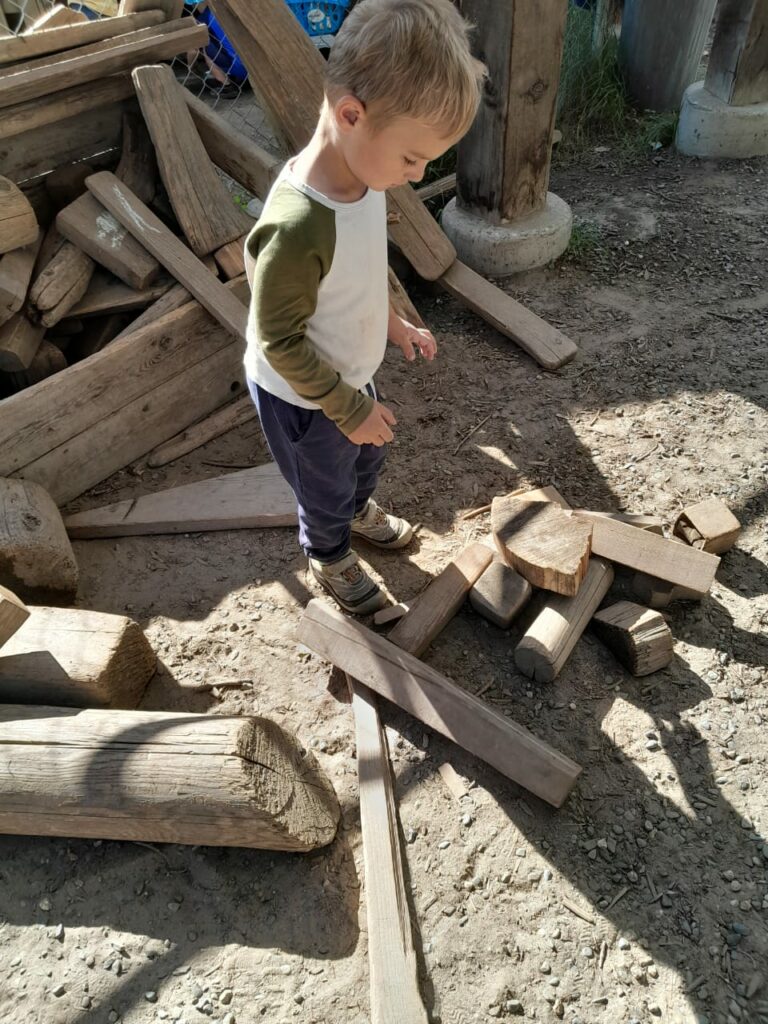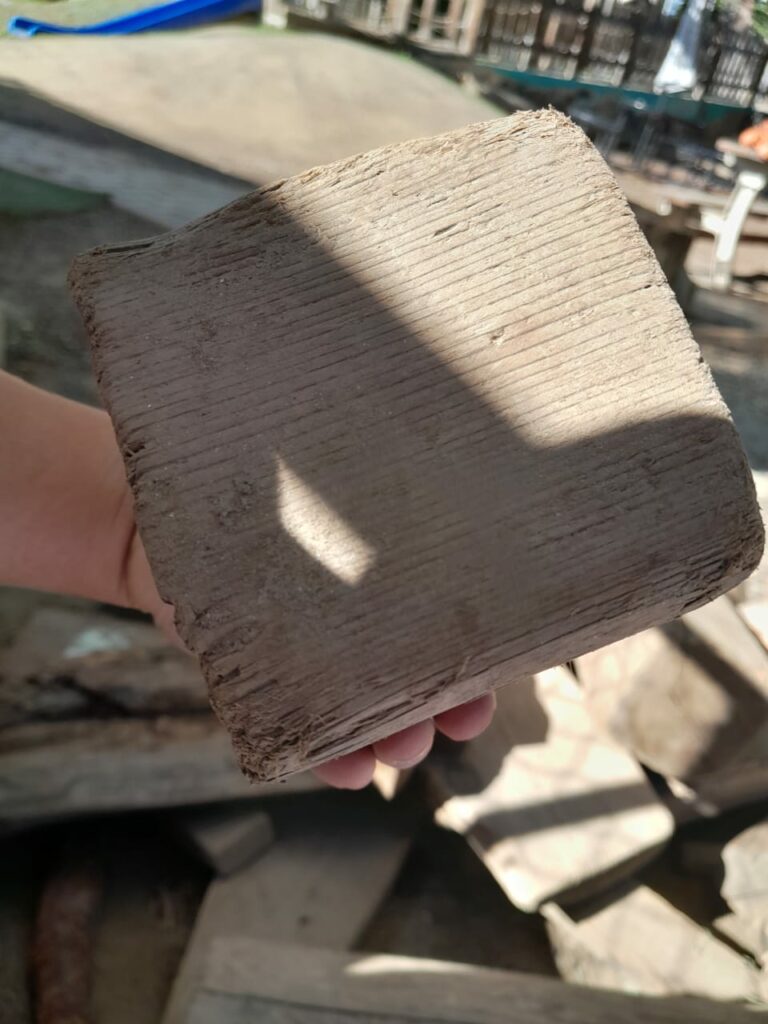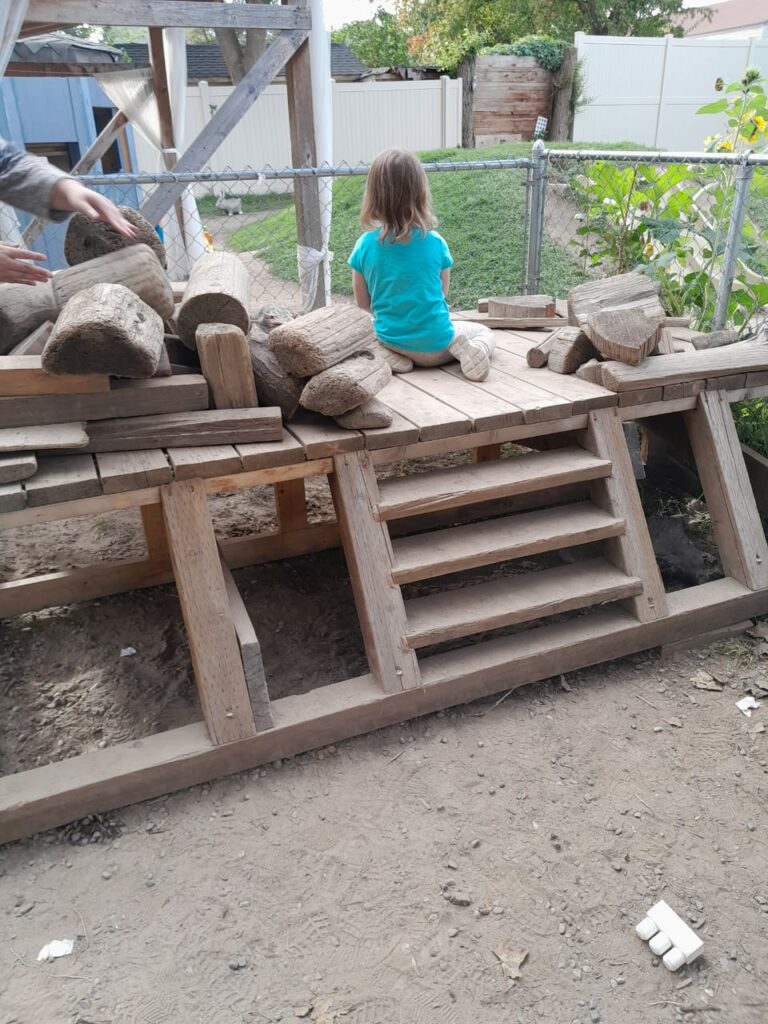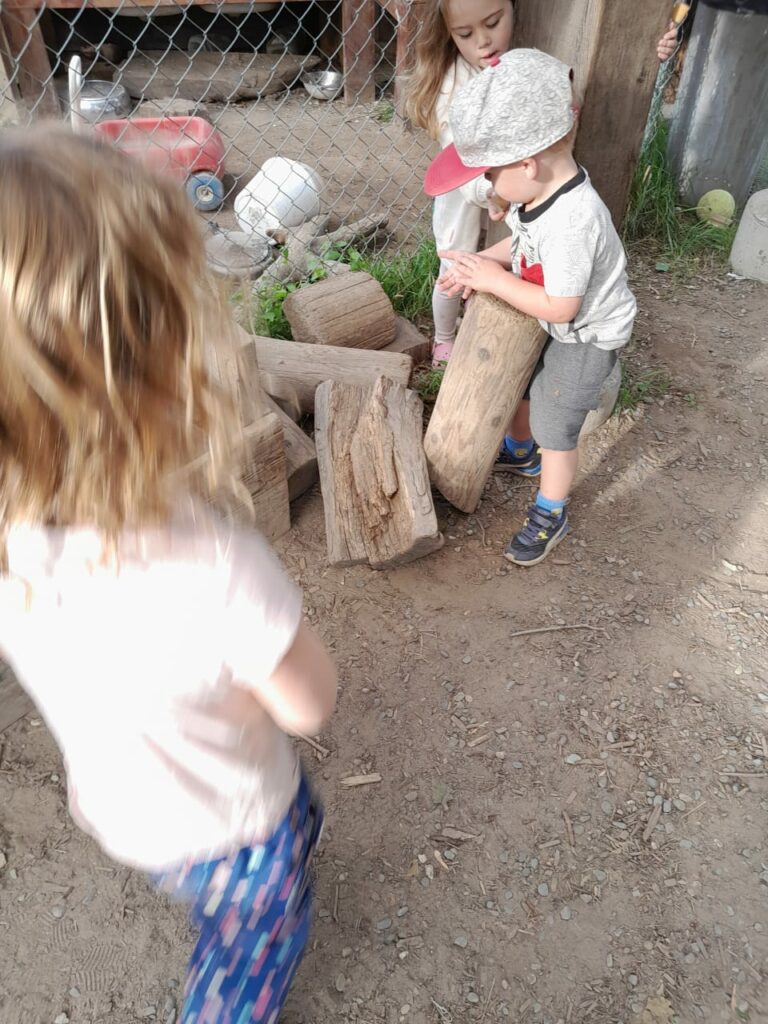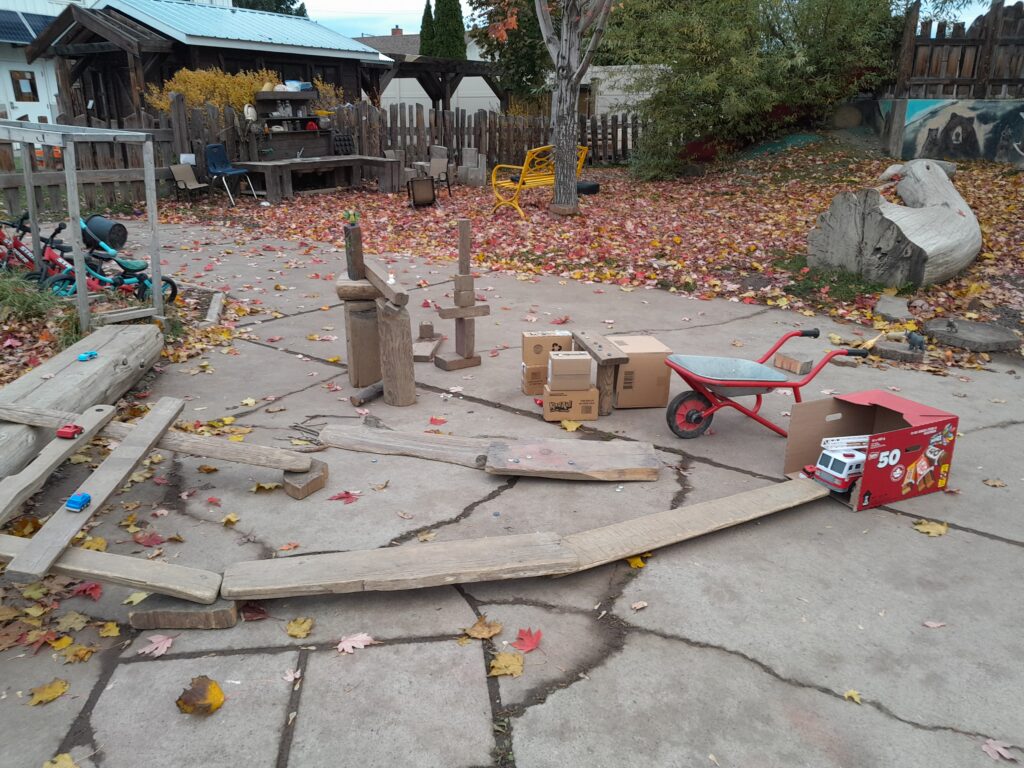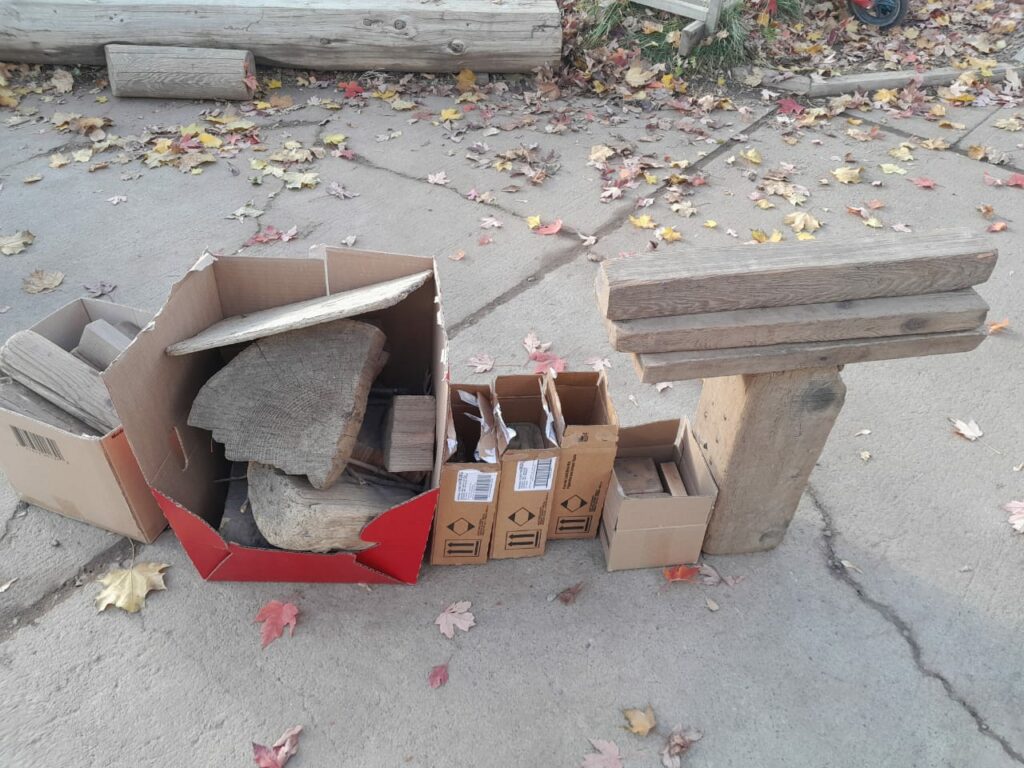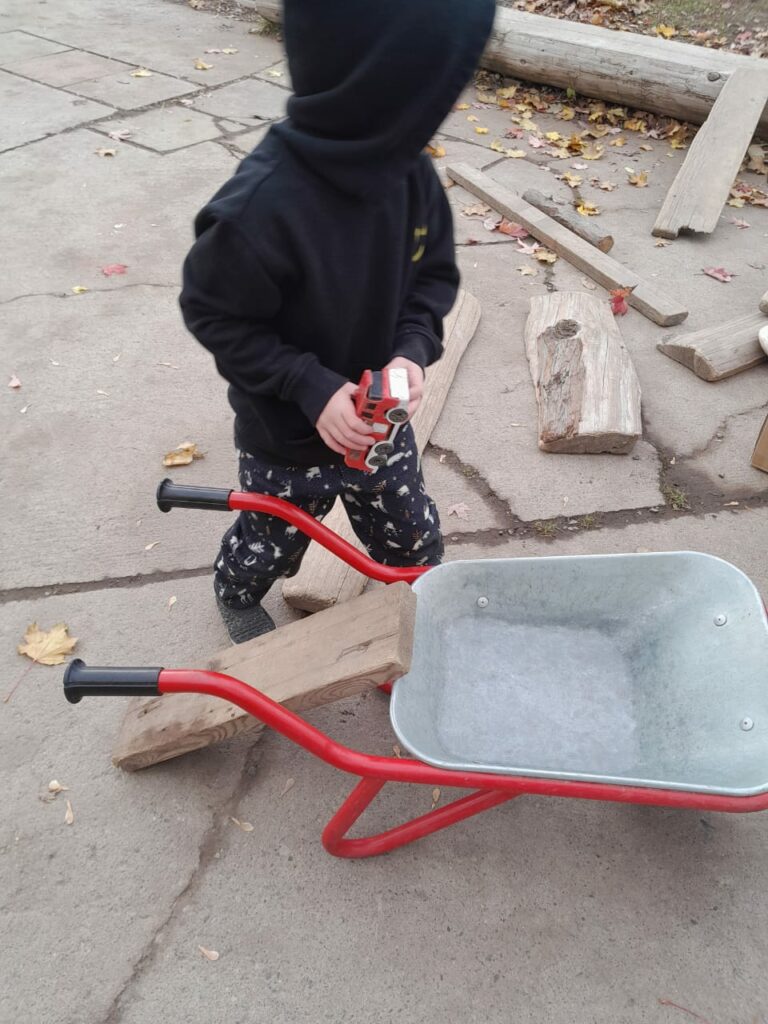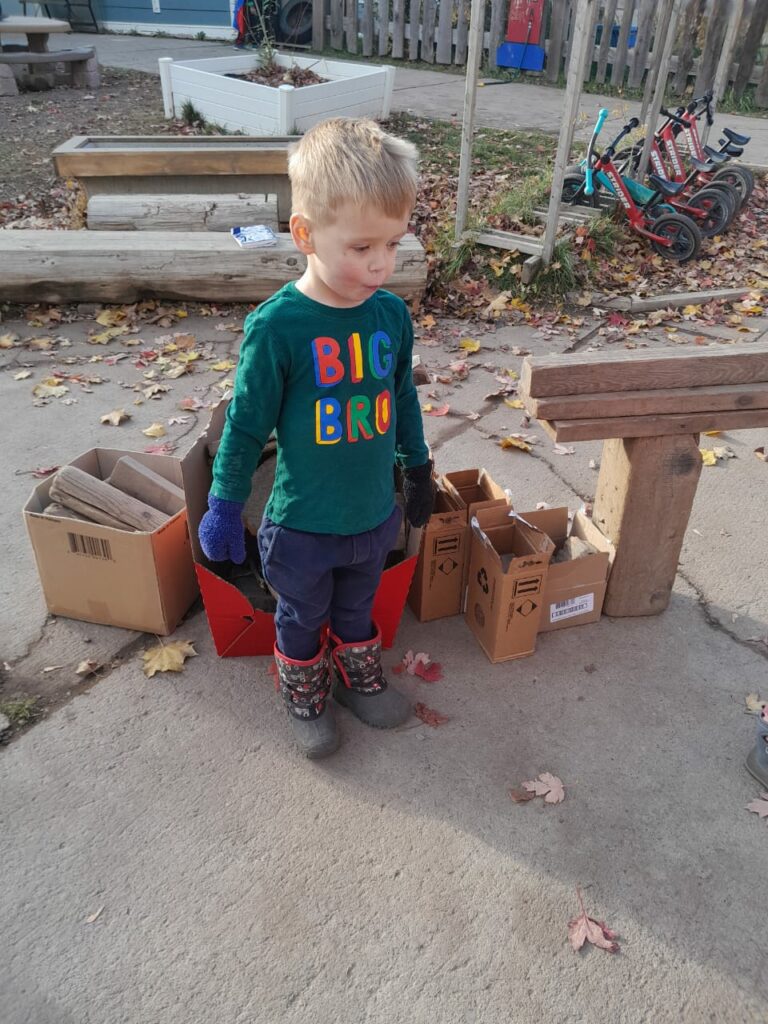CAMPFIRE
The children were engaged in play with wooden blocks. They were focused on constructing with the blocks and I could see them collaborating and working together. They assisted each other in carrying the blocks. Various types of play were taking place in this area of the playground. This situation brought to mind BCELF principle 5, which emphasizes the importance of people forming connections and reconnections with the land, culture, community, and place. As I observed them, it was evident that they were forming connections with each other and with the wooden material, representing the environment. Principle 8 highlights that relationships are essential for well-being and learning. The children were learning about the significance of teamwork, helping one another, and sharing the available space.
At another point, I noticed Revan attempting to create something with the wooden blocks, and as I engaged with him, I realized that he was building a campfire.
Resmi: What are you making
Revan: This is a campfire
Revan: This one is not heavy
This one is small
TEETOR – TODDLER
As I am with children in the yard, I stood close to the wooden blocks, hoping to witness some imaginative and creative play unfold. I was fortunate to observe the children’s creativity as they invented new things using the limited materials available to them. The kids began playing with the wood, and I was eager to find out what they were creating. I decided to ask them.
Resmi: What are you making
Child: We are making something, but we don’t know what we are making
As like the child I don’t understand what they are making, and I am curious know what is in their mind. Then suddenly the child response came
Child: Look at this, this one is big
Child: I made a Teetor-Toddler
I was amazed by their ingenuity in constructing the Teetor-Toddler using blocks and sitting on either side to showcase their creation. This brought to mind BCELF principle 1, which emphasizes that “Children are strong, capable in their uniqueness, and full of potential,” highlighting their innate strength, capability, and potential. It also resonates with BCELF principle 3, “People build connection and reconnection to land, culture, community, and place,” as children form deep connections with the land, culture, community, and surroundings, nurturing their limitless imagination and creativity. Their interaction with the blocks and the environment, as well as their connections to other places, contributes to their ability to innovate the Teetor-toddler.
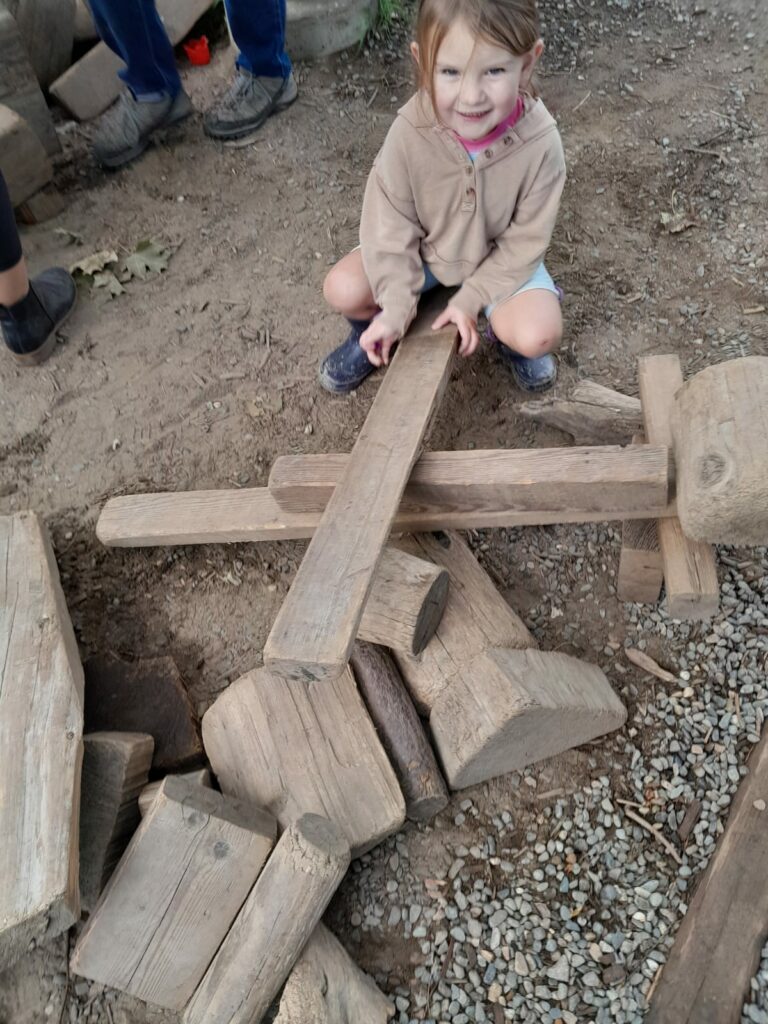
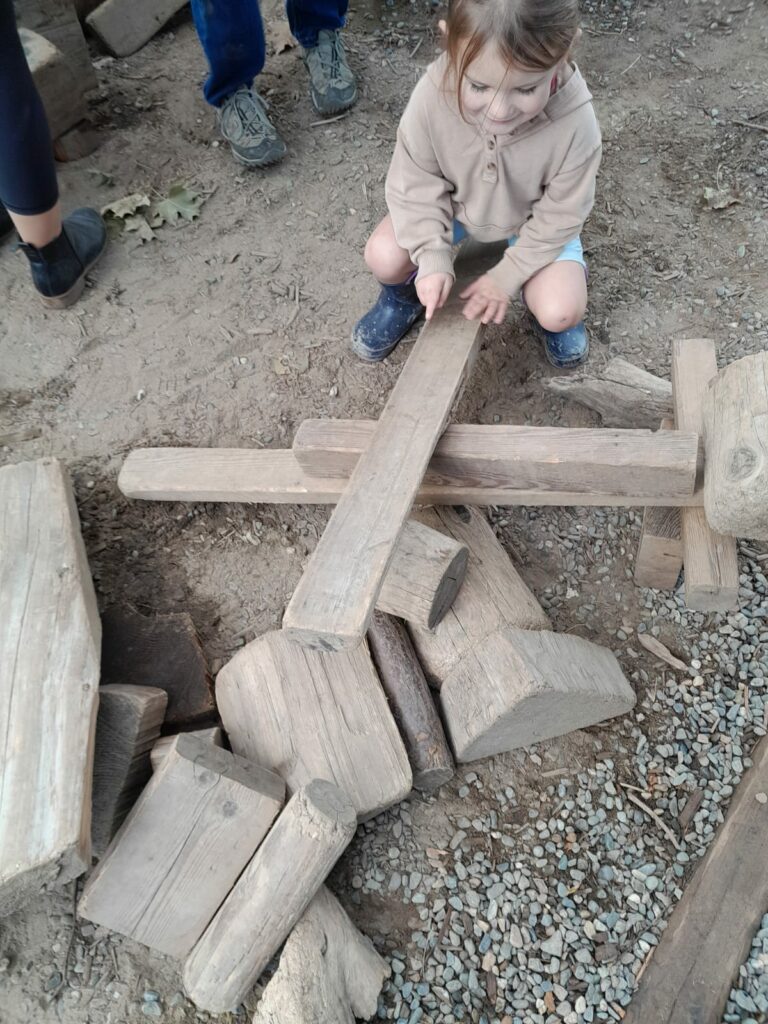
WOOD BLOCK AND COLORS
Rainbow and Grass
I considered placing various colors next to the wooden blocks to observe how the children would interact with the colors and the wood. Additionally, I positioned some muddy water near the blocks. Various groups of children utilized the watercolors and wood in diverse manners. A particular child, whom I’ll refer to as “A,” approached and painted one of the blocks. When I inquired about her creation, she explained that it was grass.
Resmi : What are you making?
Child A: We are making grass
: Green Grass
: and Dry Grass
: Dog Grass
Resmi: What Jack is making
Jack: I am making a rainbow
Child A: I am taking out to dry.
Once she finished the painting, she wanted to dry it quickly, so she decided to place it in the sunlight for drying. Although these occurrences were minor, they made me contemplate the understanding and connection that children have with the environment. It brings to mind the BCELF principle which asserts that “children begin learning from the moment they enter the world and it is not a linear process.” Their connection with the land, community, culture, and surroundings broadens their knowledge. It’s remarkable how they relate everything to nature.
Feet Painting
Upon arrival, Benjamin began exploring the various colors and expressed his desire to fill in all the spaces. He commenced coloring the wooden block, using different color combinations, leading to some engaging conversations.
Ben: I am cover this whole space
: Its black
: I am mixing it with red
Resmi: How did you make this color
: Black, Red, Blue
Resmi: Its Purple now
Ben: Now I am doing feet painting
I am curious about the color combinations he used in his paintings, as well as his use of mud to paint the blocks. In the end, he placed his feet on the block and called it “feet painting.” This brings to mind how children utilize their imagination and powers of observation. The BC ELF principle emphasizes that learning is holistic and doesn’t follow a linear progression, often taking unexpected directions in connection with people, places, ideas, and materials.
HOUSE
Meavis is interested in constructing her own house using wooden blocks. She considers this house to be hers and meticulously stacks the blocks to create stairs, making sure to leave space for her baby as well. Here is a video showing her process of building the house.
HOUSE TO FIRE TRUCK HOUSE
Dharan and Logan began constructing a house after they painted the wooden blocks they had. When Dharan began painting, I inquired about what he was doing.
Resmi: What are you doing
Dharan: Something
: You see
Dharan: I am using all the colors
Once the painting was finished, he and Logan moved all the wood blocks to the other side of the yard. I was curious about their plans for the wood blocks. When I asked him what he was doing, he said he was building a house. Dharan began constructing the house, and when he finished, he placed his wheelbarrow in the middle and proudly declared that he had made a fire truck house. He celebrated loudly and enthusiastically to mark the completion of his construction. According to the BCELF principle, “People establish connections and reconnect with the land, culture, community, and place.” I realized that he was connecting with the local community where he grew up. Children develop a sense of place when they engage with the community and the outdoor environment. “Early learning is ‘of a place’ when children and educators explore local histories with respectful curiosity and a willingness to contribute and share” (BCELF, Page-21). As the child learned about the local stories, he was actively engaging and expressing his curiosity and desire to share the event that had taken place.
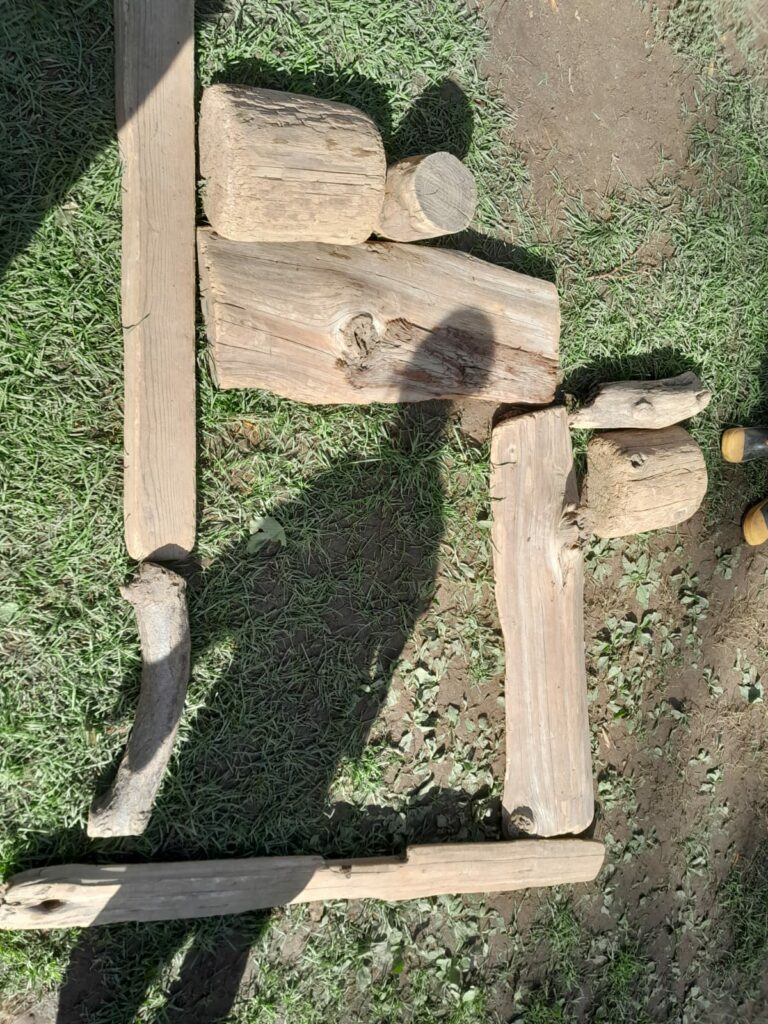
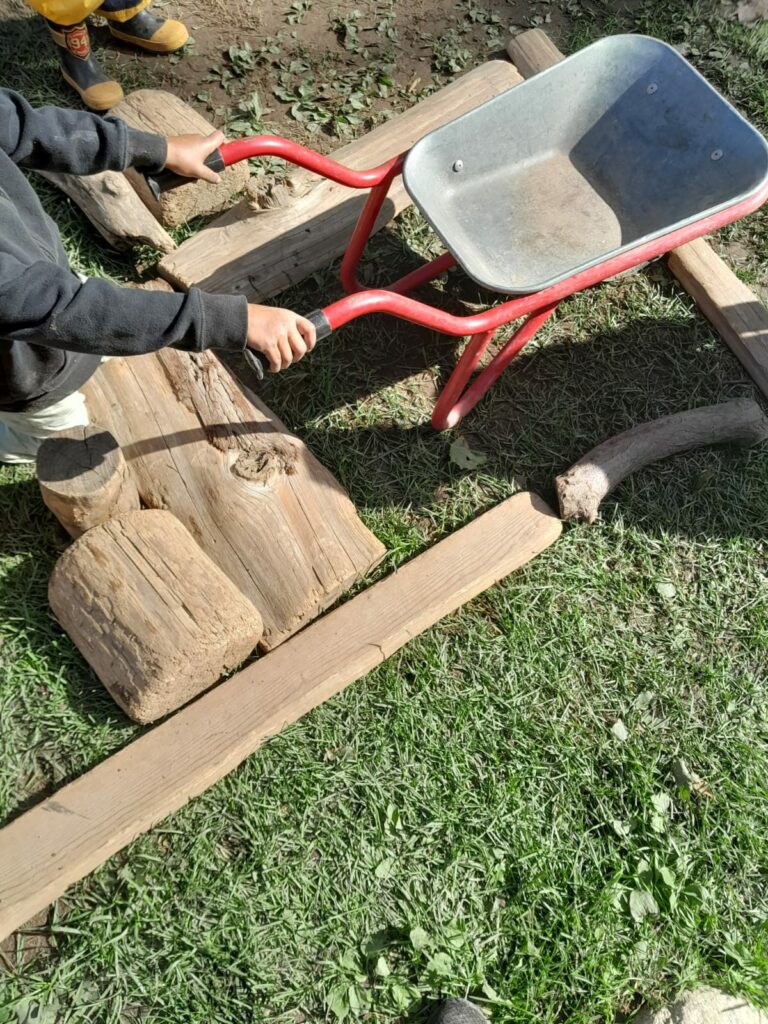
FIRE STATION
Dharan, Trovi, and Reavn are interested in constructing a fire station. They transport all the blocks from one end of the yard to the other. They begin stacking the blocks and, in the process, they determine which ones will fit on top of each other.
Resmi: I wonder what are you making today
Revan: A house and a fire station
Dharan: When we die we turns us back into a log
: We do it in trick
: All logs covers all our eyes, often it is dark and we cannot see anything
Dharan: I have to connected
: This can be closed
: These are the hammers, these can goes there
Torvi : Take a picture
Torvi: We need more wood
: This color I want
: Used for bad guys
: If they come inside, it cuts them turning apart and they will die.
Throughout the construction process, I noticed that they are making connections to everything they see and hear. They are linking everything back to the community they live in and to the culture they come from. I found it fascinating to see how they connect each moment of their life. For example, when Dharan shared the story about turning into a log after death, it was linked to his religious and cultural background. In Hindu culture in India, dry wood is used for cremation and to cover the body. Hearing this made me marvel at how he connects everything he does to his cultural background and the community he lives in. After hearing about the Red Bridge fire a few weeks earlier, Dharan started constructing fire stations and fire houses. This reminded me of the BC ELF principle, which emphasizes people building connections and reconnecting to land, culture, community, and place.
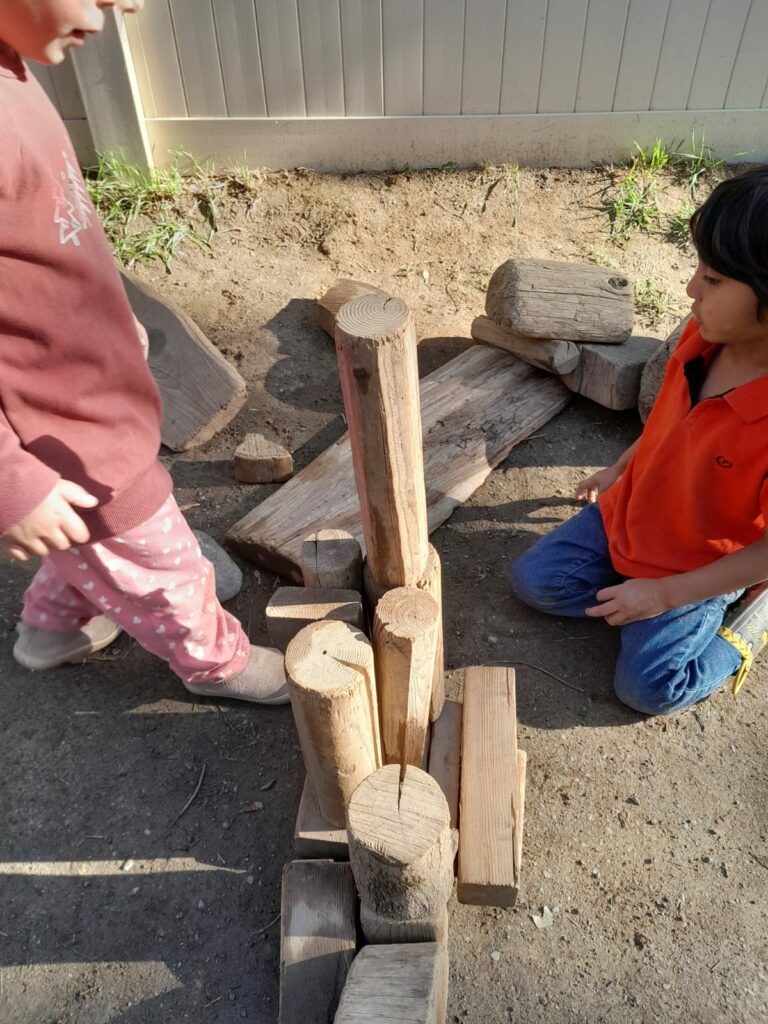
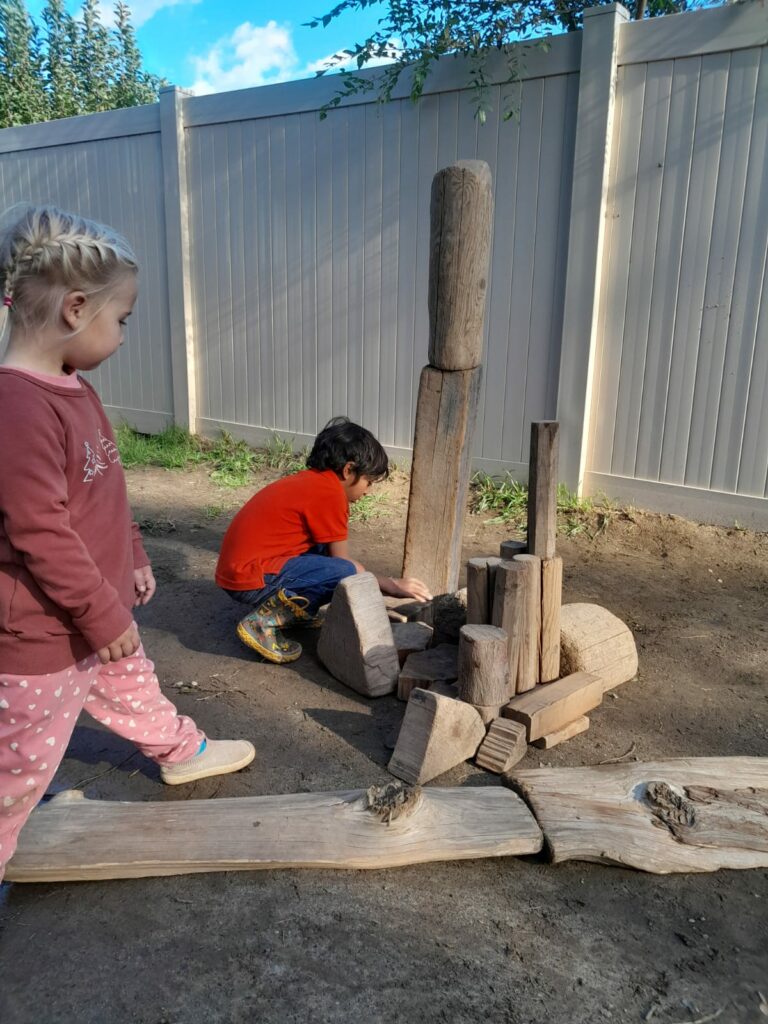
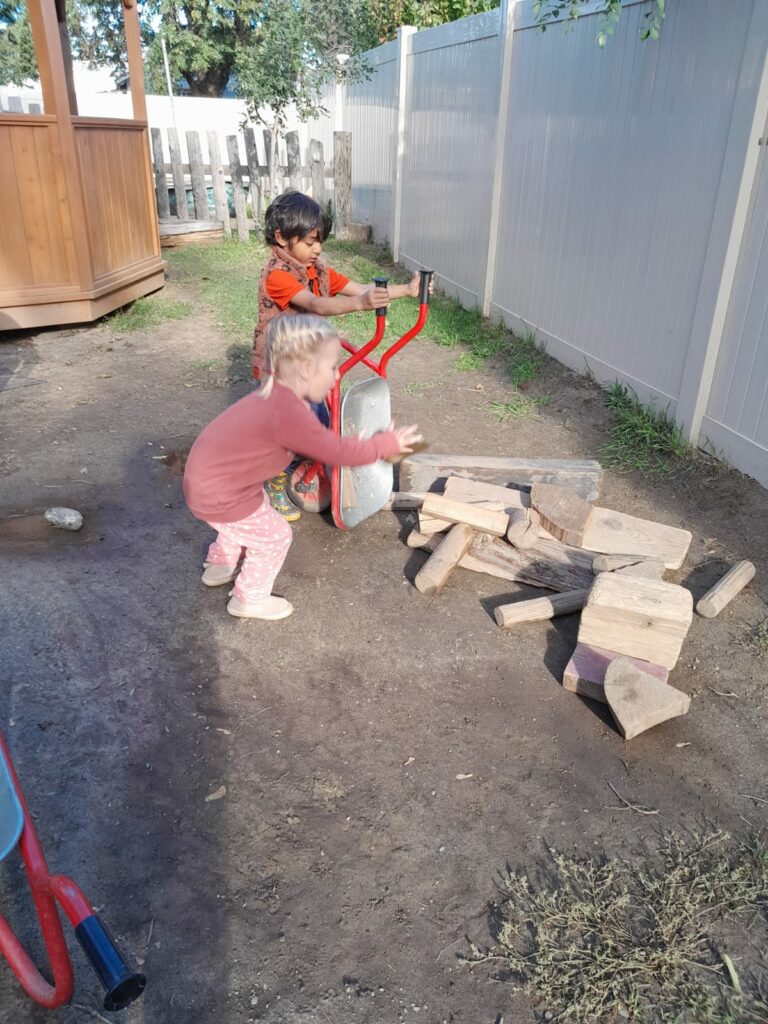
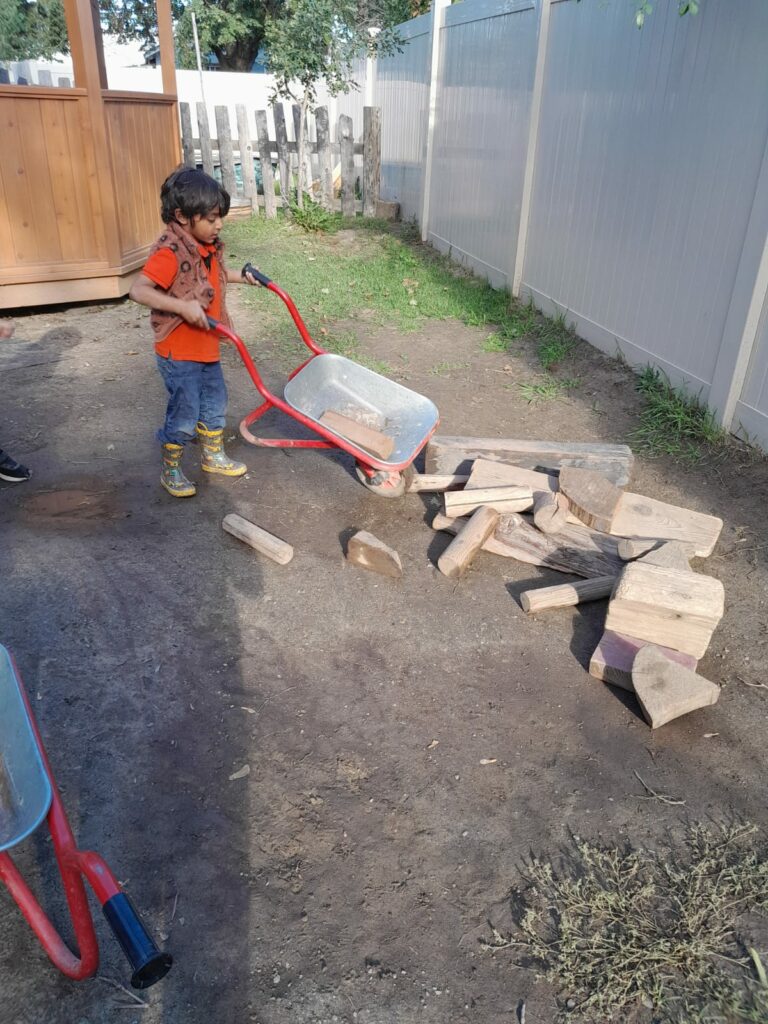
CASTLE
Ternwell: We are building a castle
Torvi: I am the princess and they building a castle
Dharan: I am the night Dog
: This is my Gun
Ternwell: You are breaking the Castle
Dharan: No I a putting it here, look out that I fixed it.
Resmi : Who is living in the Castle
Torvi: I am the Princess
Ternwell: And I am the King
Today, Ternwell, Trovi, and Dharan are completely immersed in the world of castles, princesses, kings, and watch dogs. They are using blocks to construct a castle, and I believe they are drawing inspiration from a story they’ve recently encountered. It’s fascinating to see how children weave their own narratives based on their experiences, what they have heard, or what they have seen. According to the BCELF Principle, environments play a crucial role in fostering well-being and facilitating learning. I can confidently assert that they are engaging in self-directed learning through their play and the environments they are a part of. I recognize that learning is comprehensive and can take various forms.
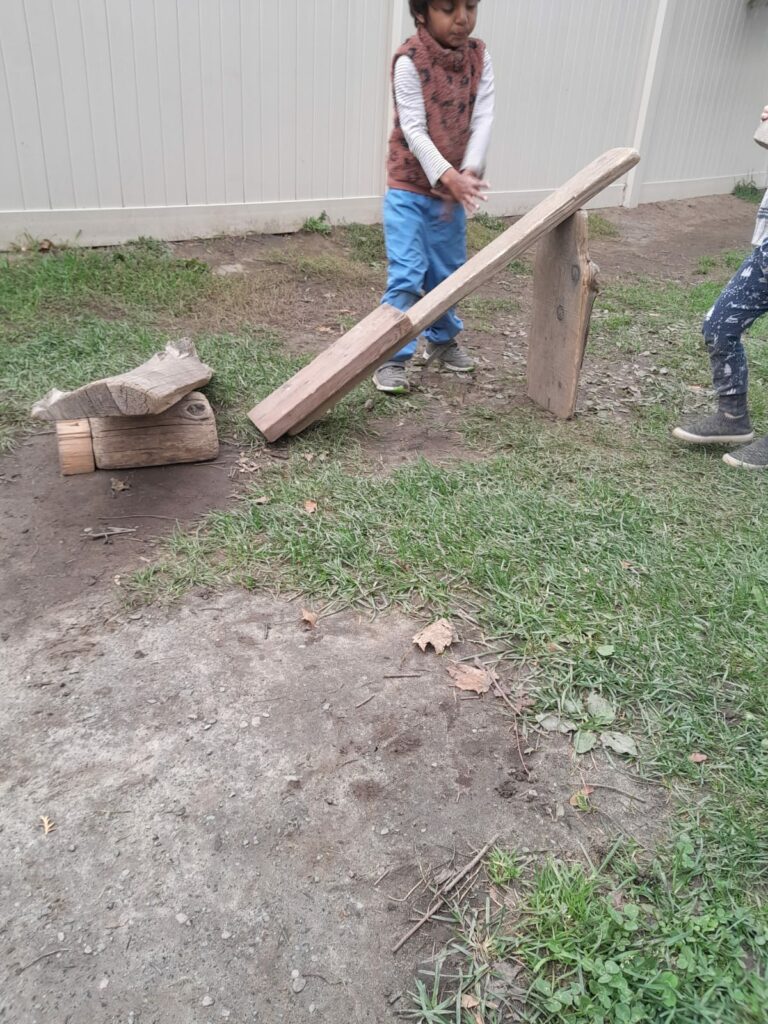
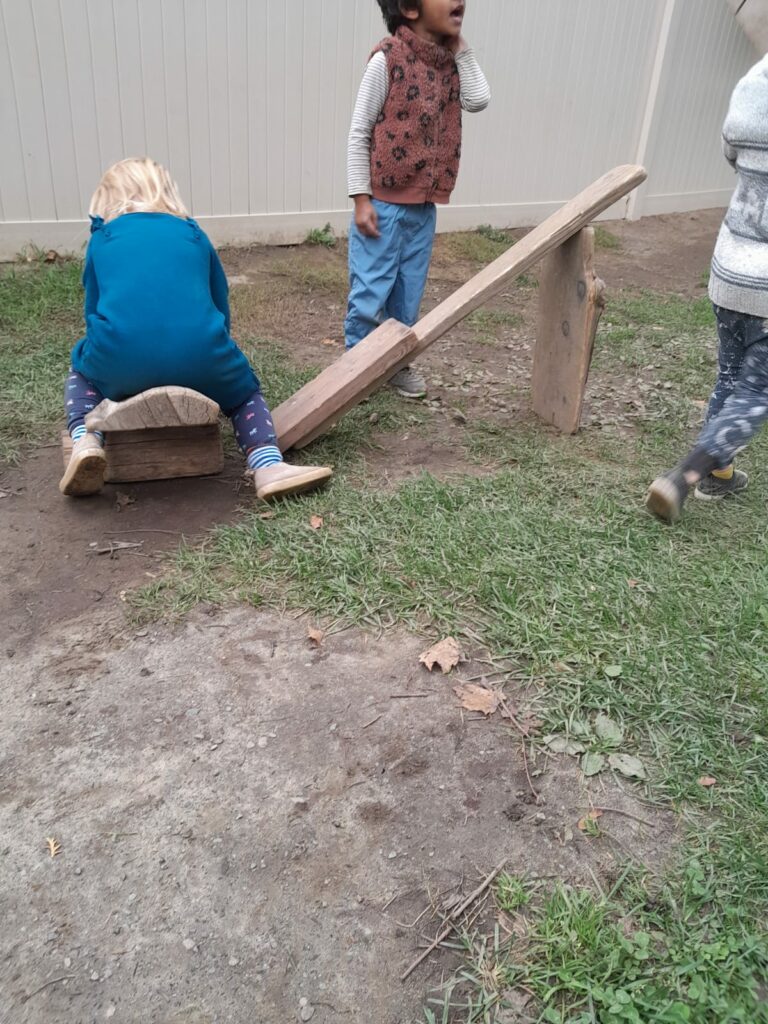
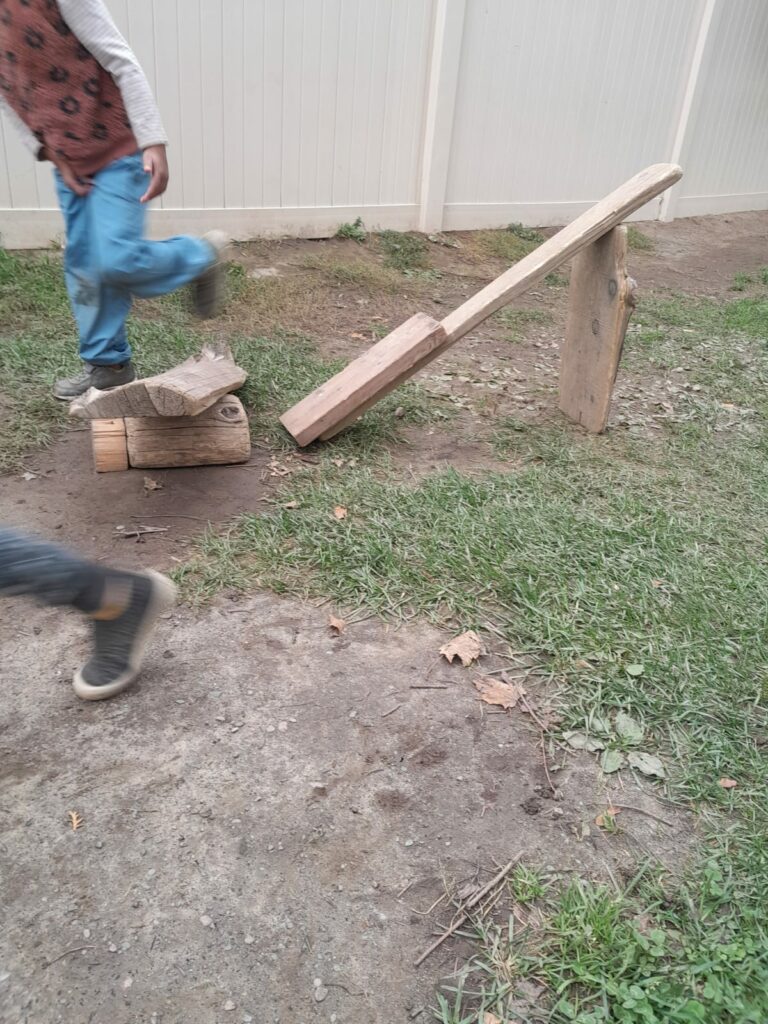
Crazy Waterfall Castle
One day, I chose to share images of various buildings like bridges, castles, houses, fire stations, and cities through interactive games.
The following day, while we were inside, Jack began to create something; upon closer inspection, I noticed he was meticulously arranging wooden blocks in different configurations. He positioned one block at an angle on the table and started to build on top of it. Later, I inquired about what he was making, and he told me he was constructing a castle. On the table, there was a miniature forest with a bear, a log, and a picture of flowing water. Once he completed his construction, he connected the angled wood block to the tip of the water flow. Other children also joined with him and add materials like small vehicles into it.
Jack: It is a water fall castle
: Crazy waterfall castle
: The water fall all through this way
: here then fell here ( by showing with hands how the water flows)
This prompts me to consider how he interacts with the materials in his surroundings. He began his construction using wooden blocks and incorporated other materials from the table. Or is he independently enhancing his activity by integrating those materials? This reminds me of the BCELF principles, which emphasize that environments play a crucial role in well-being and learning and that individuals create connections to land, culture, community, and place. His relationship with the land, community, and environment, along with other materials in the world, may assist him in building a “crazy waterfall castle.”
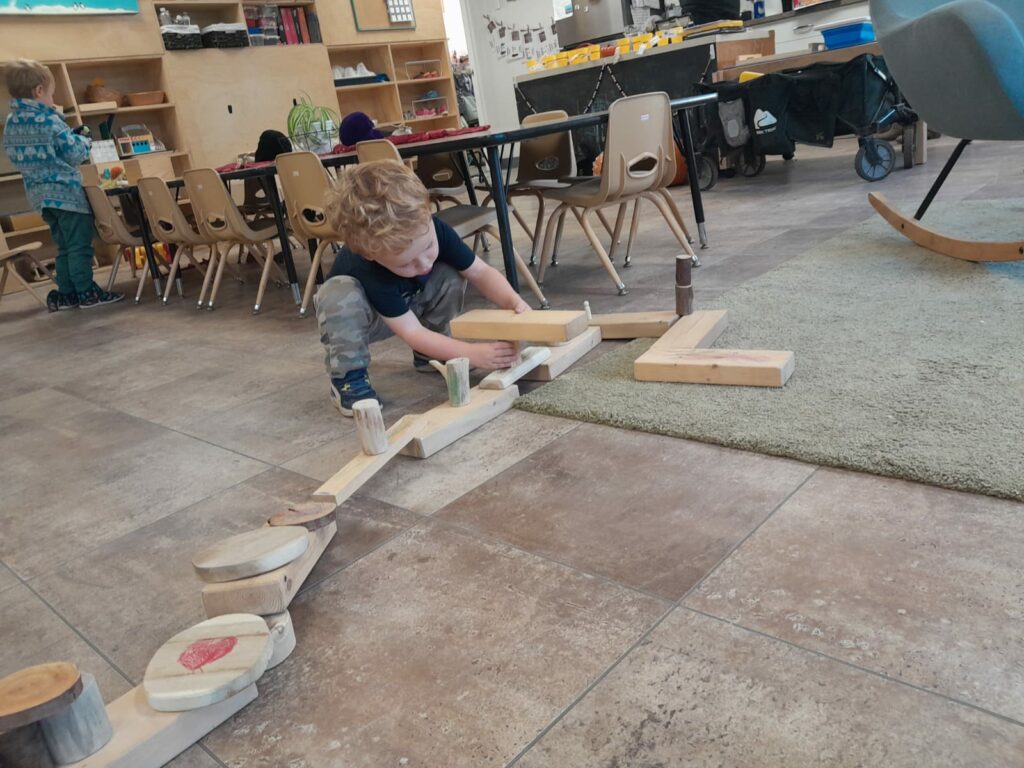
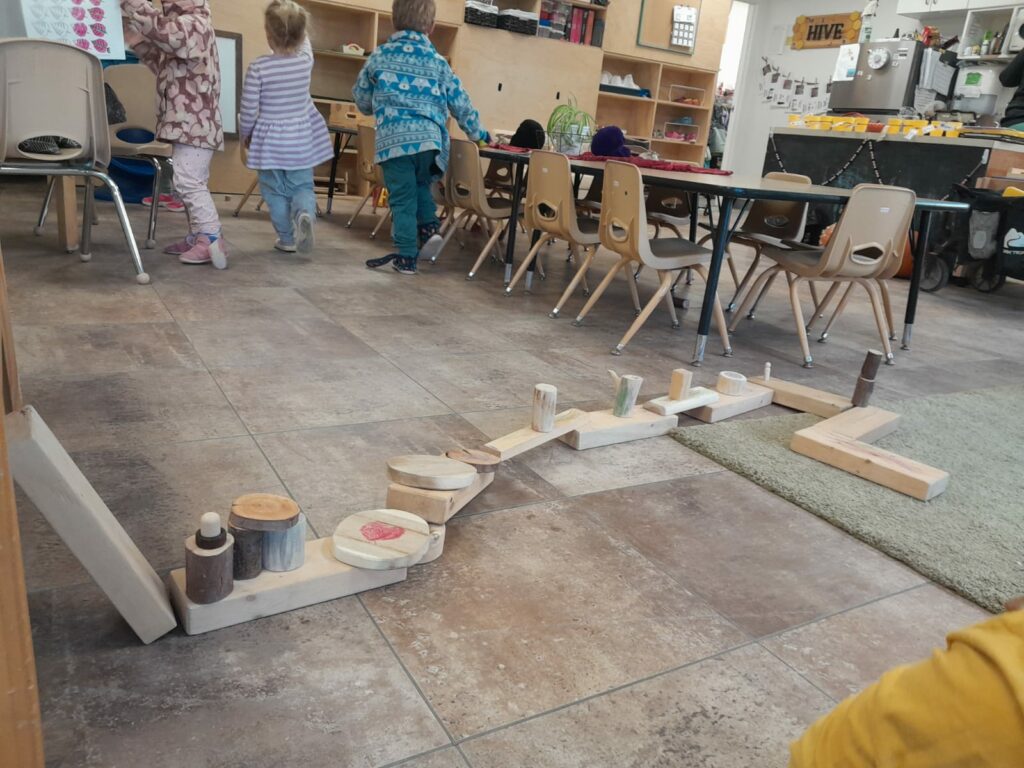
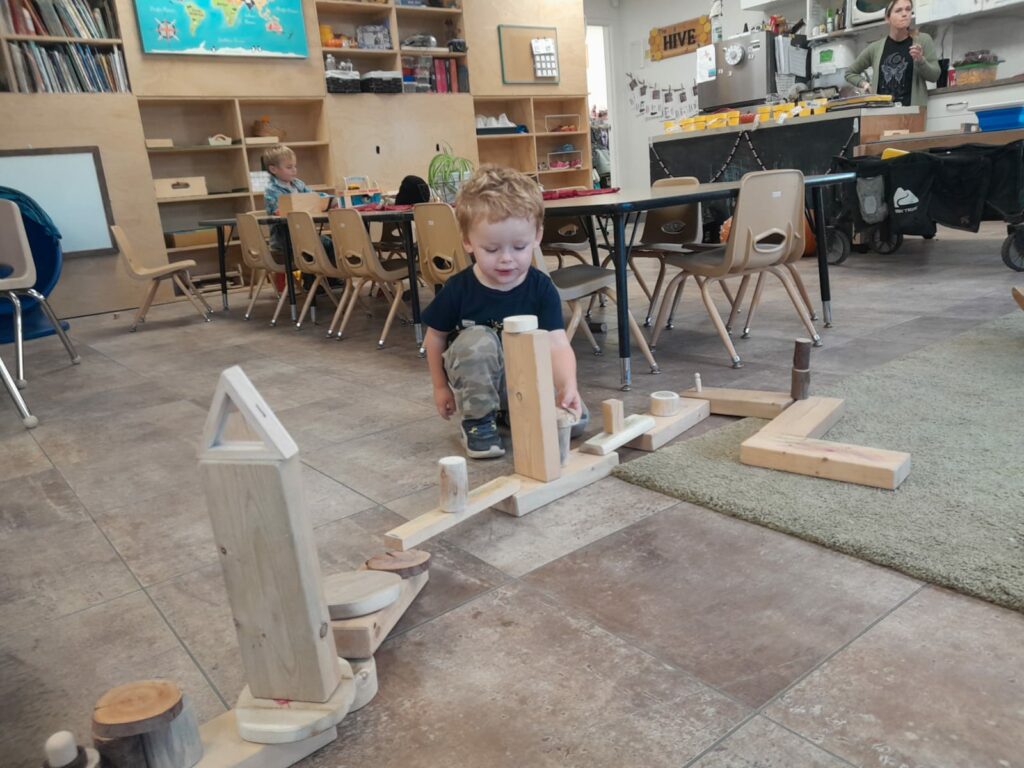
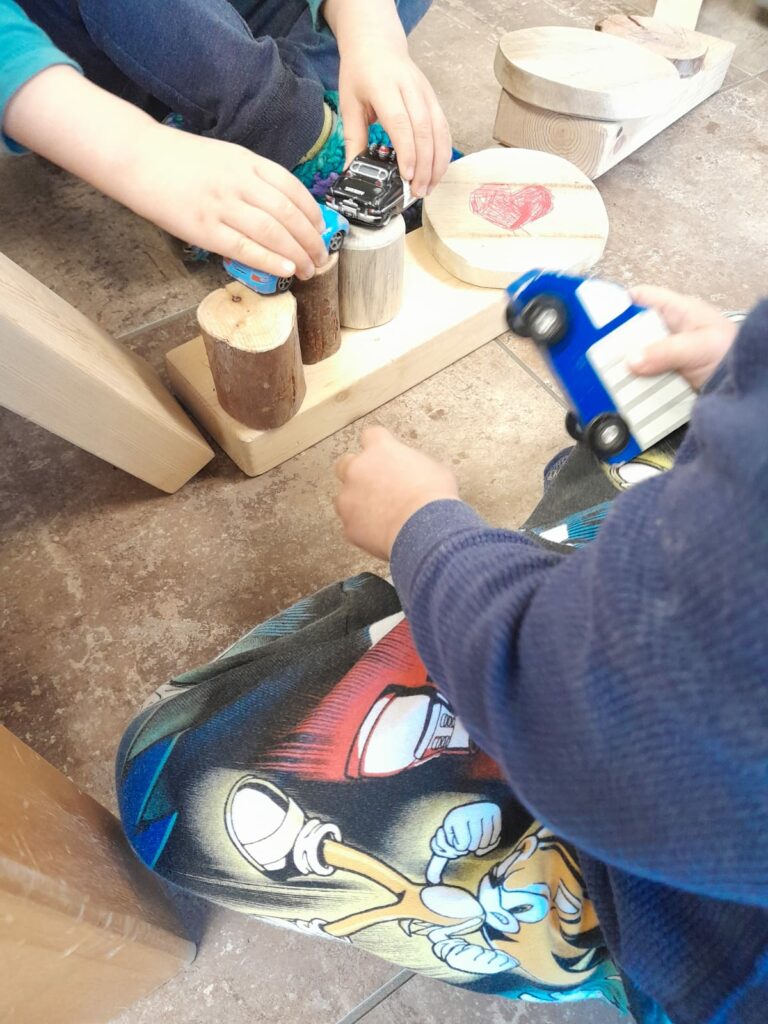
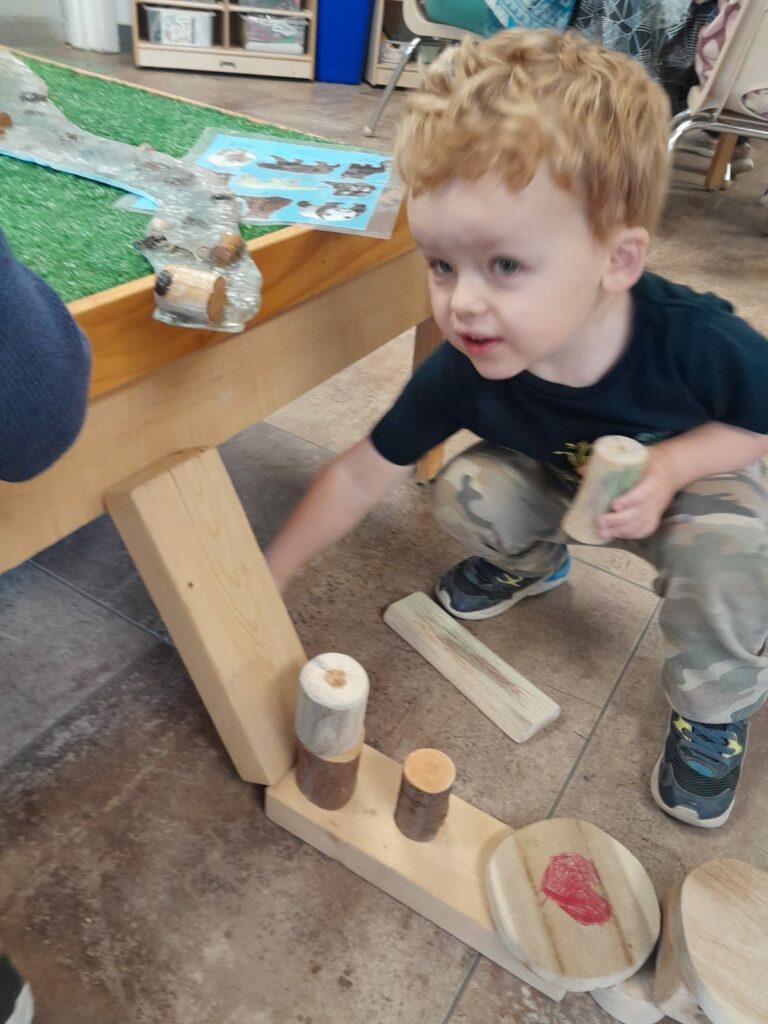
Castle Extension
What if the children themselves find ways to extend the construction using other materials?
One evening during our free play time inside the room, I noticed that Jack had begun building something with the wooden blocks. Everly, intrigued by his activity, joined him to help organize the blocks. When I asked what they were creating, Jack mentioned it was “nothing” because he doesn’t know what is in construction. Later, when Everly insisted it was her house, Jack mentioned it as a Tower. Shortly afterward, Revan also became involved in the building process. I was impressed by how carefully they positioned the blocks and how well they collaborated on the construction. I sat nearby and quietly observed their activity. As their creation grew larger, they declared it a castle. They added various items from a nearby table to embellish it with small plastic trees, a bench, a lamp, and more. I was amazed by their ingenuity in incorporating additional materials into their project and the teamwork displayed among them. The construction process took over an hour, and none of us interrupted them or announced snack time. This allowed them to engage fully for as long as they wished until they became tired of the activity.
According to the BCELF principle, children are inherently strong and capable, possessing unique qualities and potential. Every child is born with distinct talents and abilities. The connections they establish with people, materials, and their environment support them in realizing their full capabilities. A child’s interaction with their land, community, and surroundings enhances their limitless imagination and fosters a sense of adventure, as outlined in the BCELF.
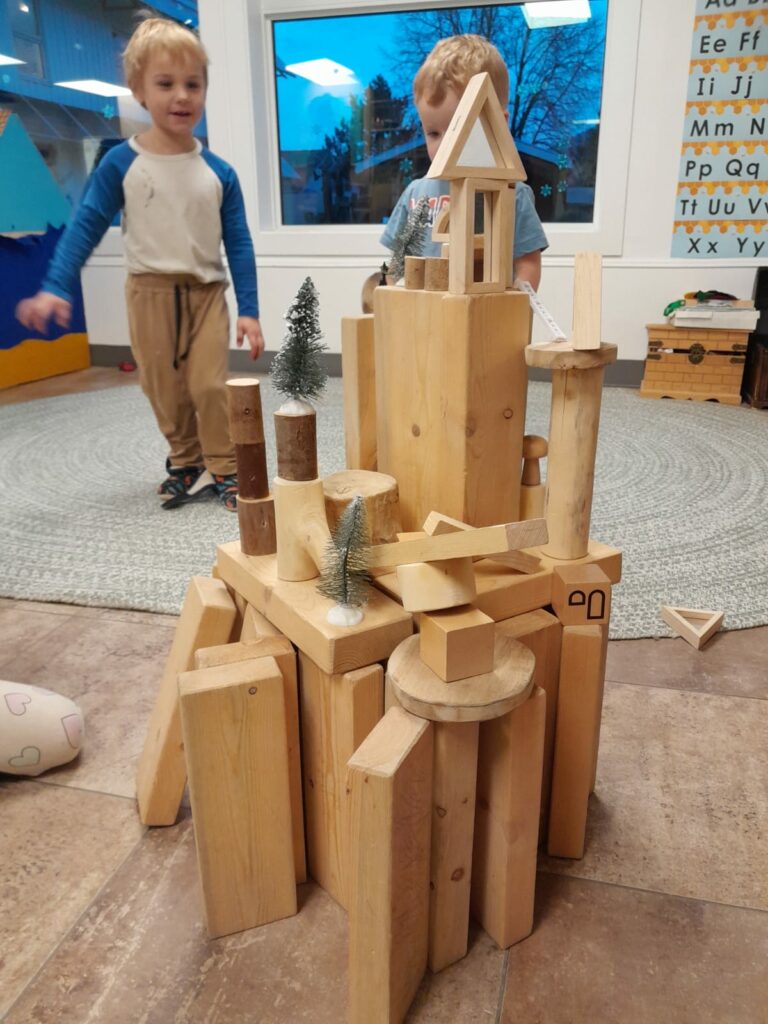
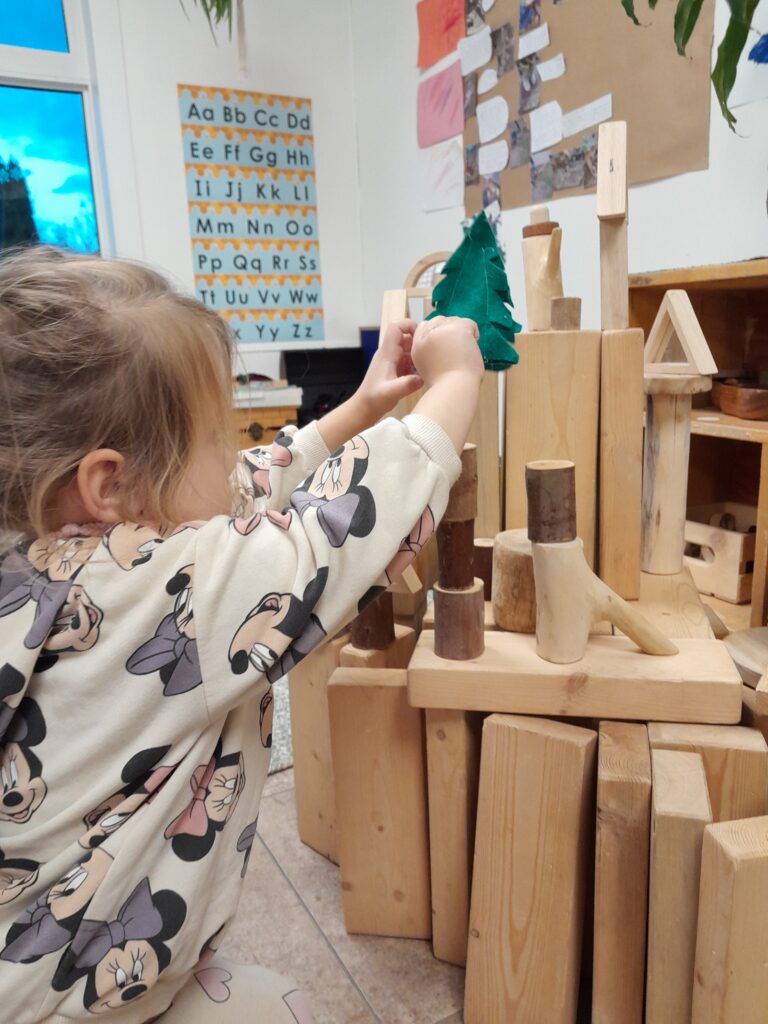
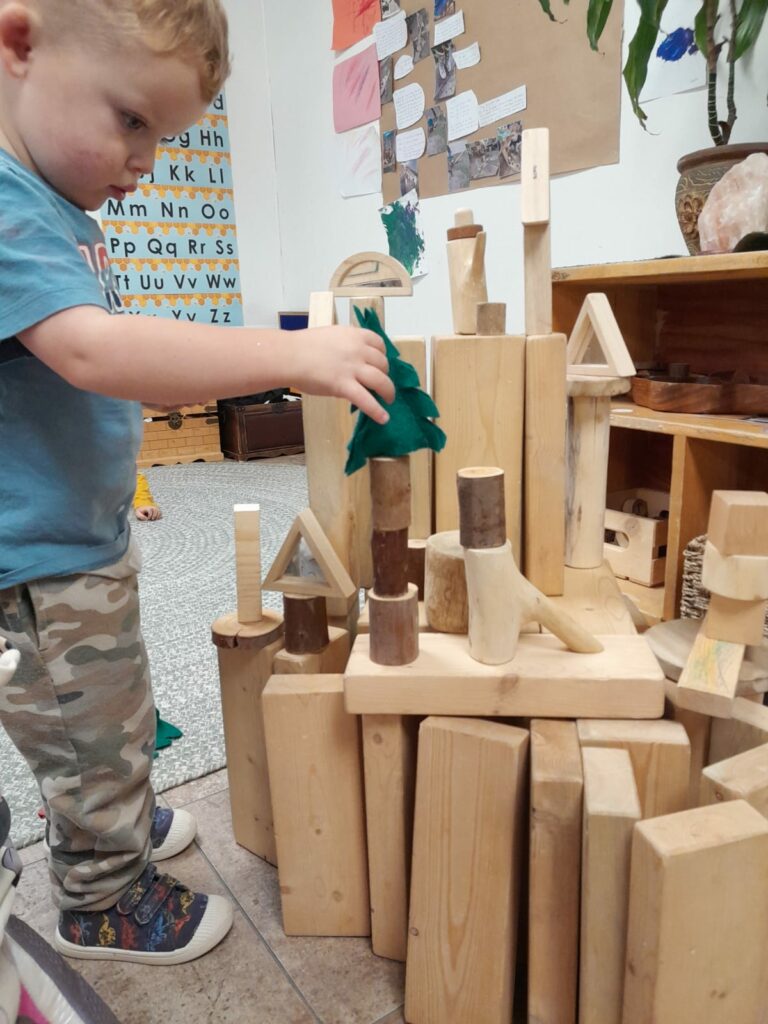
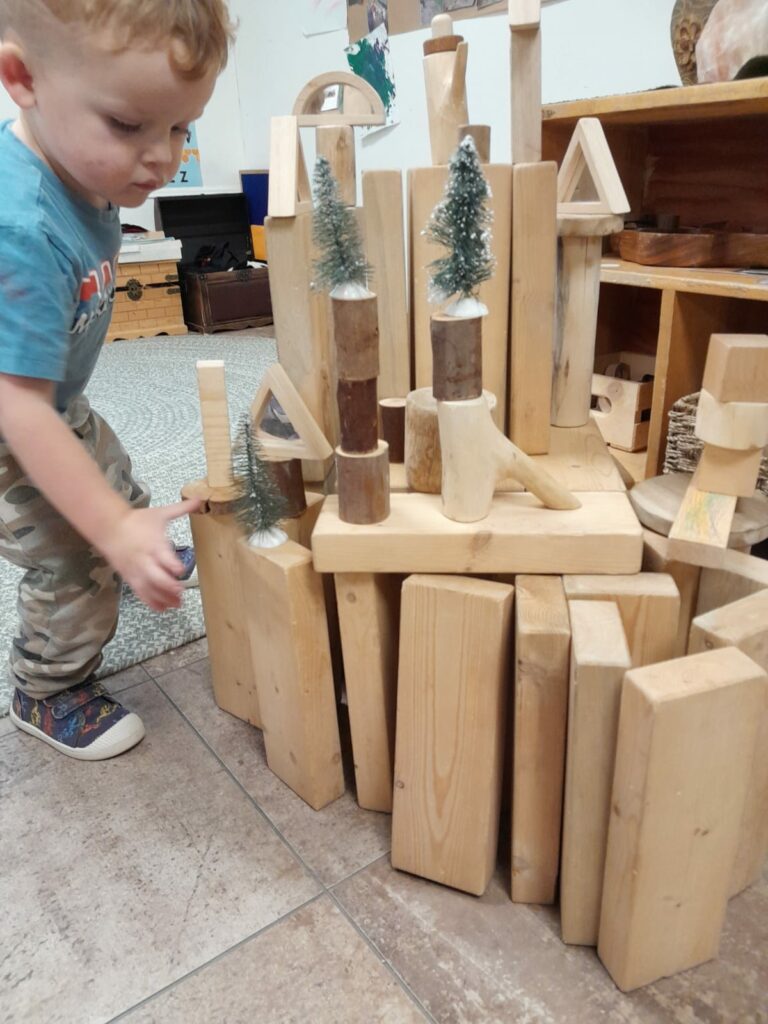
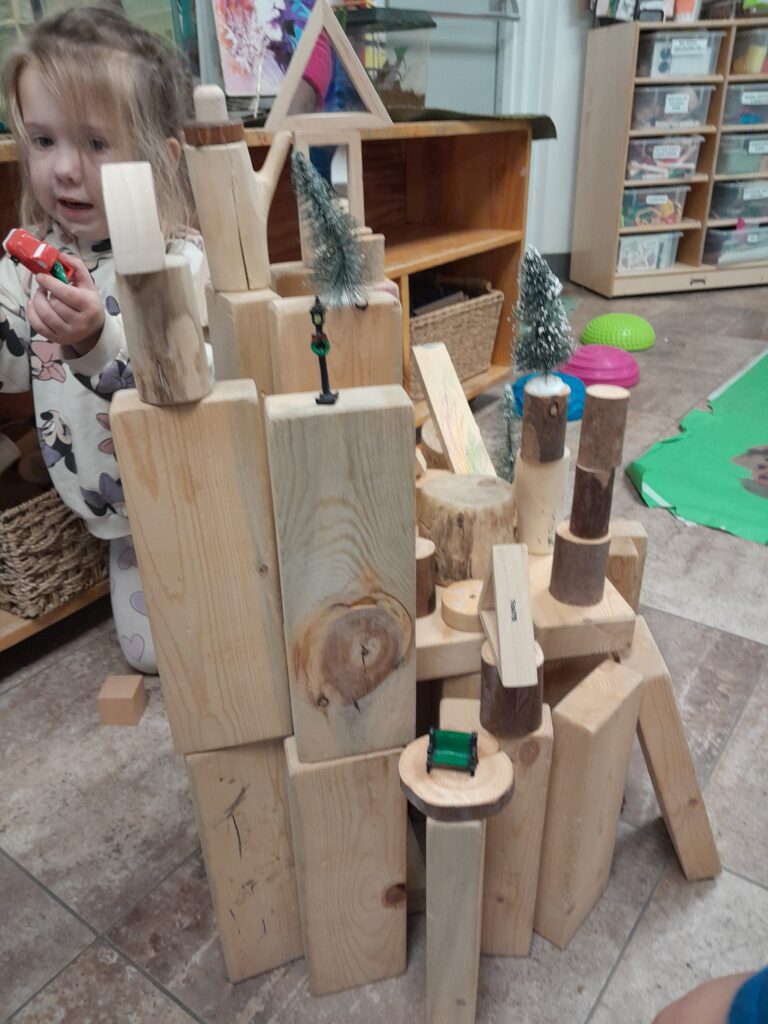
BRIDGE
Eric”: There is no water
: It all dried up
When I spot Eric, he is moving all the wooden blocks from one side of the yard to the little pond. Erick and Graufen are working on something, and I have no idea what they are into it.
Educator: When there is no wood over there
Eric: Nothing happen
Revan: What are you doing Erick
Eric: I am putting all the wood over there
Educator: What are you gonna do
Eric: I am putting here
Educator: What if all the wood taken from here
Eric: I will put it back
Resmi: Why are you putting all the woods here
Erick: Because I want to
Graufen: Because I want to
As I watched him work, I realized that Eric is quite particular about selecting the wood. He attempts to balance the wood in the wheelbarrow and took every wood block from the pile and put it in the pond. When he reaches for a wood block from the pile, he discovers a bug on it and wants to get rid of the bug, so he tries to remove it using another block and then he asks
Eric: How did the bug of the wood
He maintains this task for about an hour, selecting blocks from the stack and placing them in the pond. After a while, he gathered some dirt in the wheelbarrow and wheeled it close to the small pond. I am now wondering what he is goanna do and he asked me to save the barrel. In the evening he continues the same process and when I asked him
Resmi: What are you making
Eric: Bridge
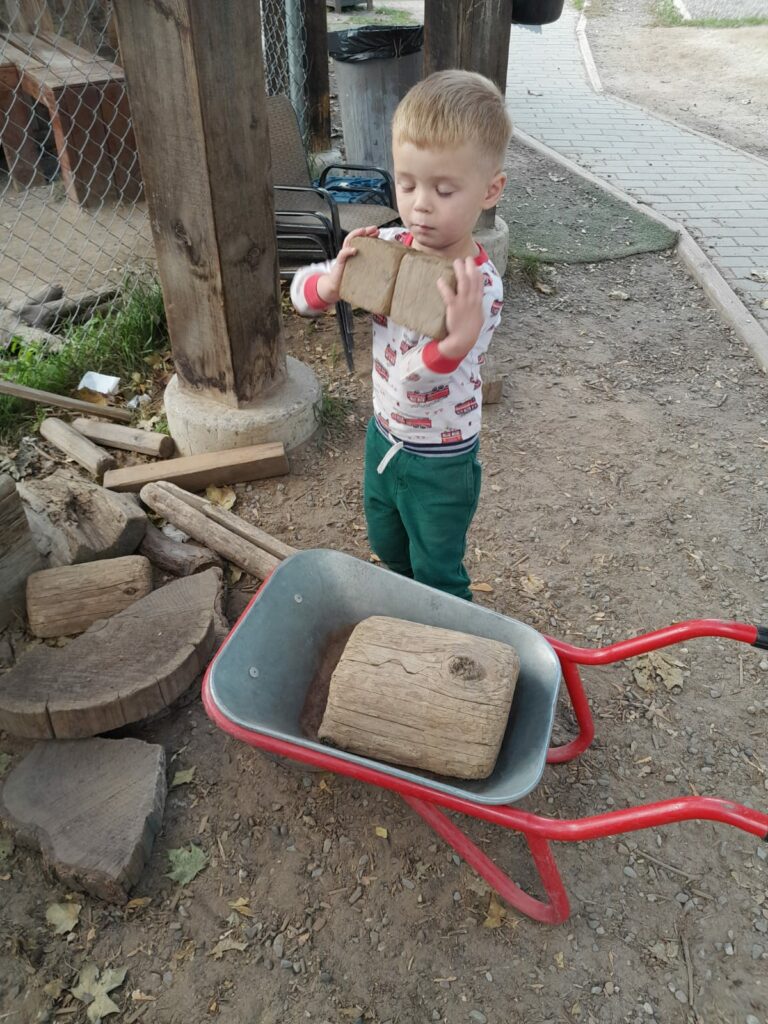
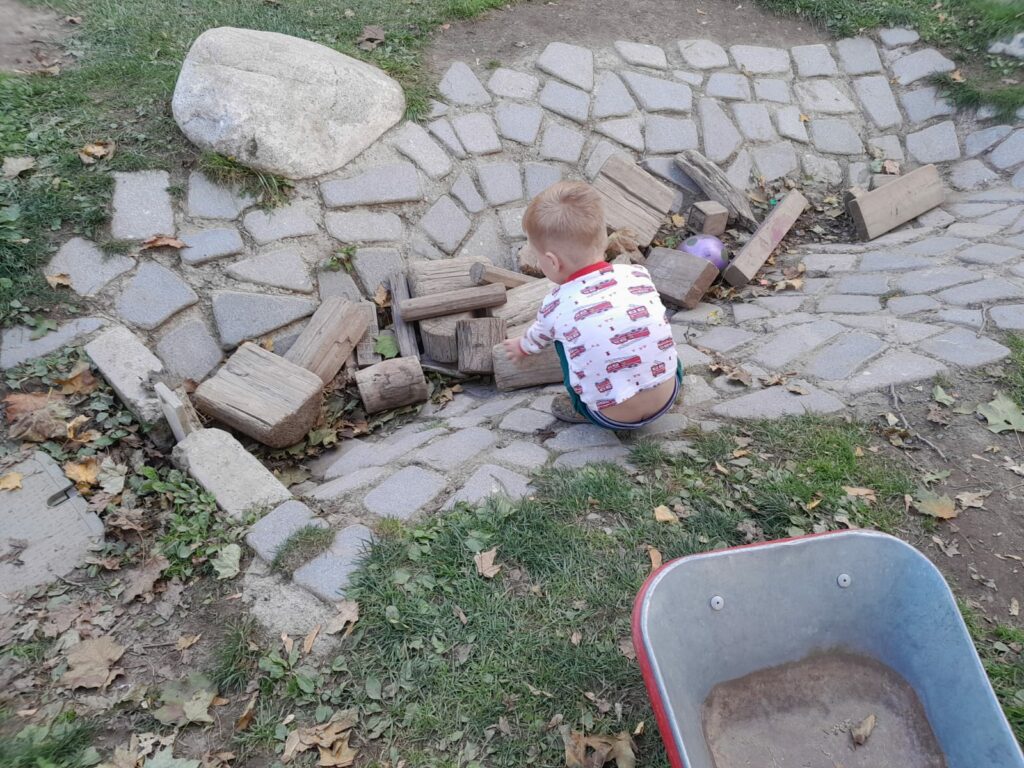
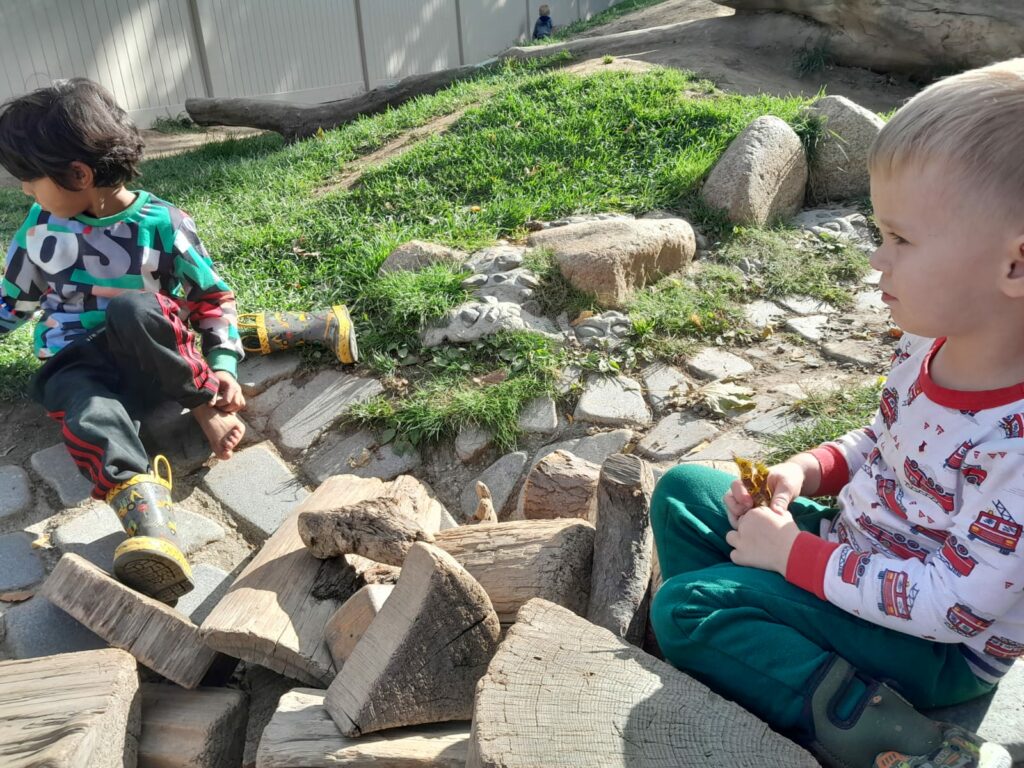
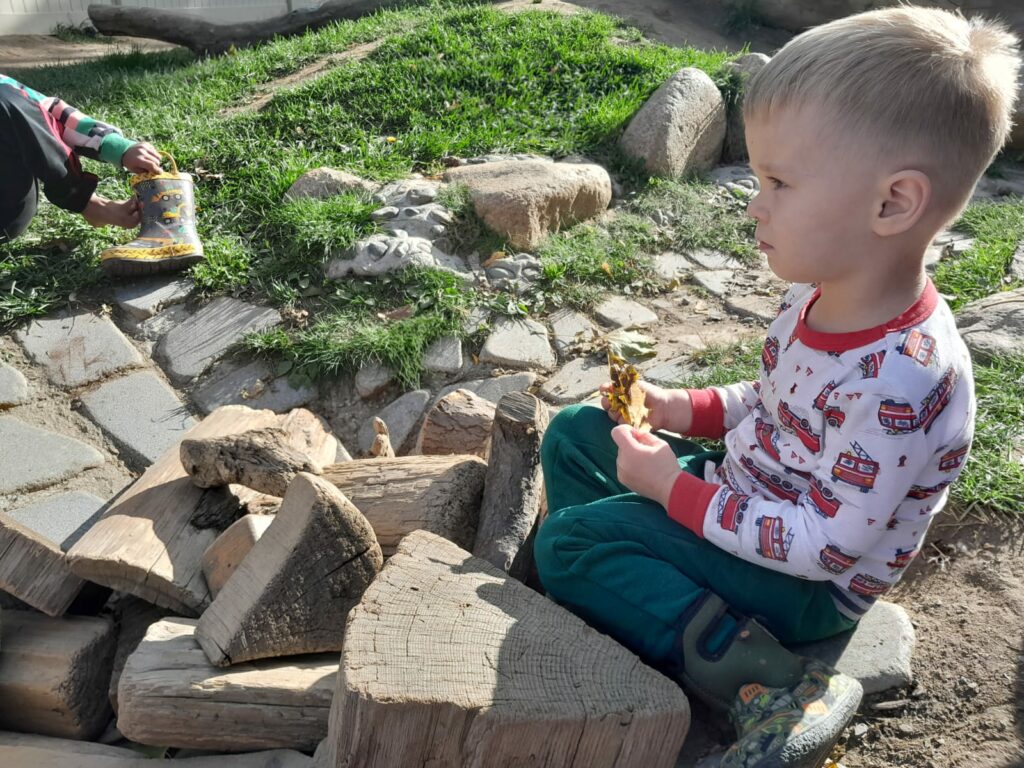
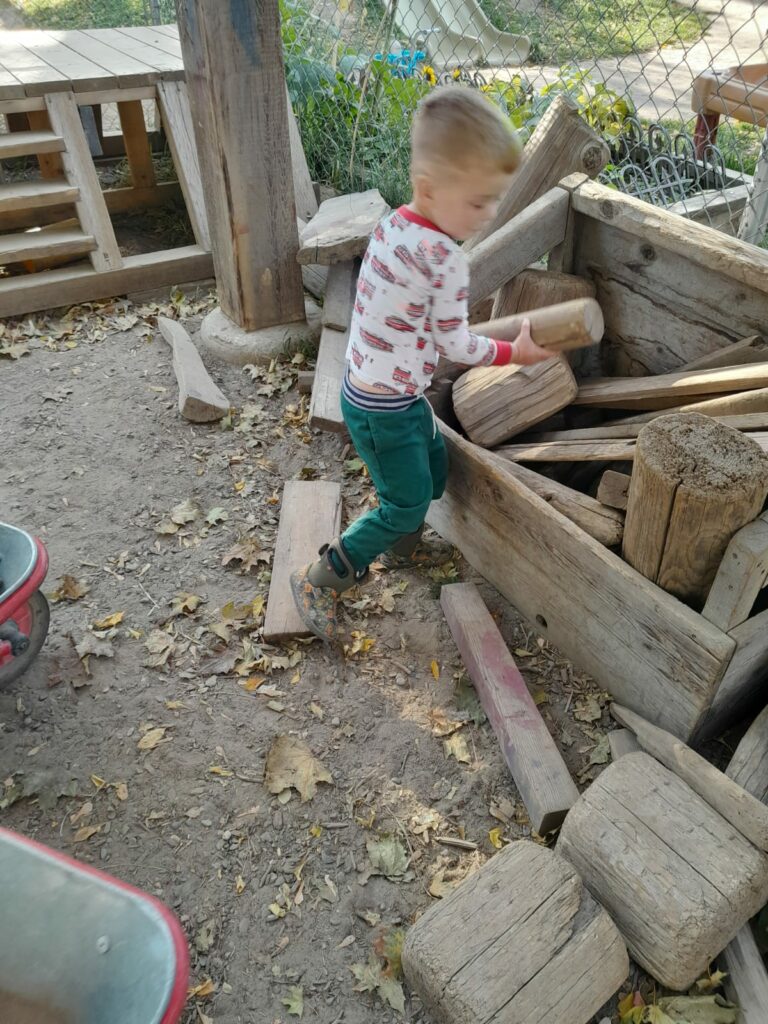
The very next day he started process of collecting all the wood blocks from the pile and put it in the pond.
Resmi: Why do you want to build the Bridge
Eric: Because I want to
Resmi: Where is the water
Eric: It all dried up by Sun
I don’t understand why he wants to build the bridge all day. What influences him to build the bridge? I am wondering whether it is the material or anything else? These are some of the questions that comes into my mind.
On the way to collect blocks from the pile he pointed at a Tree and said
Eric: That tree is naked
Resmi: Why do you think it is naked
I didn’t get any answer for that, but I am wondering what made him think like that? Is the Tree is naked? Does the leaves started falling? Not that much it has leaves in it. I am wondering why he thinks like that or is there any story for him to say.
Anyway he transferred all the wood blocks from the pile and put it in the pond and thus he made the Bridge.
When I saw he put some leaves into the pond I asked him
Resmi: Why did you put leaves?
Eric: The leaves need to be there
Revisiting
One day I decided to revisit the construction of the children for that, I showed them the different pictures of the bridges, cities, houses, and castles.
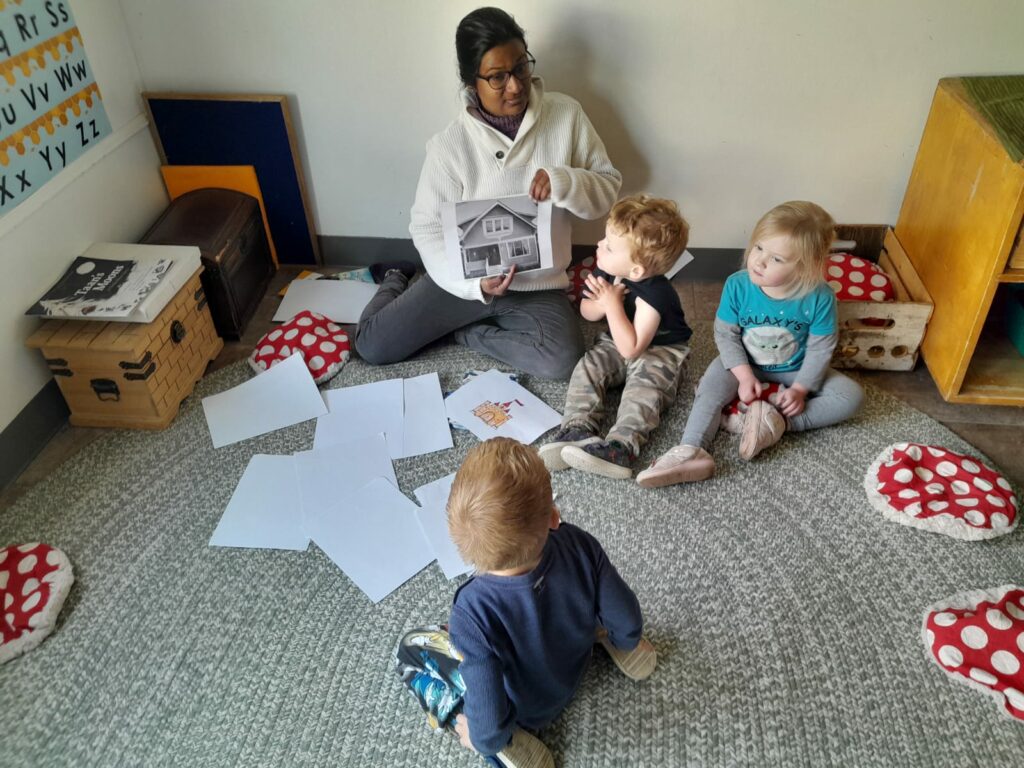
Wall Bridge
As again Eric started his construction of the Bridge, but this time it is inside the room he brings all the blocks and carefully arranged in a way that looks like a wall. He carefully hammered each wall with hammer. Later some time Revan and Jasper joined with him in between. Eric started explaining about his construction.
Eric: This is wall Bridge
Revan : I wanna knock it down
Eric: This Bridge is for my Mummy
: Mummy can walk through this Bridge
: This Bridge is for Mummy and Dad
: These are tyres
Resmi : Why do you wanna put tyres
Eric : Because I wanna move the bridge
: It is a road Bridge for mummy and dad
Revan : It looks like a fire station
Eric : These are water trucks my Mummy gonna loved it.
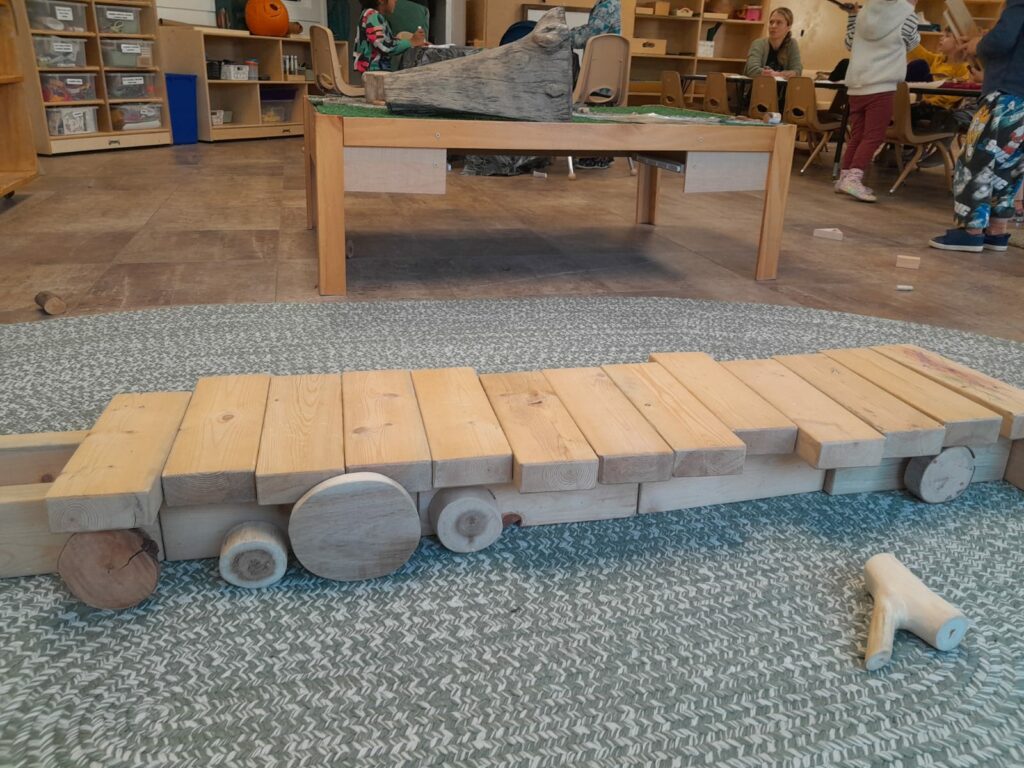
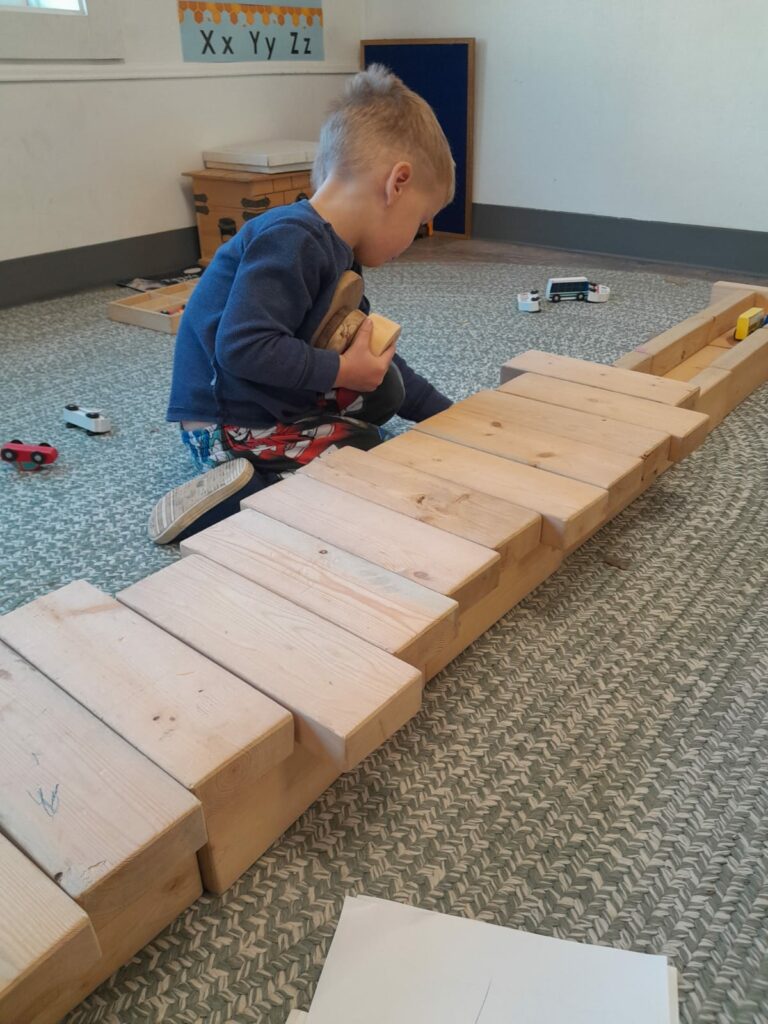
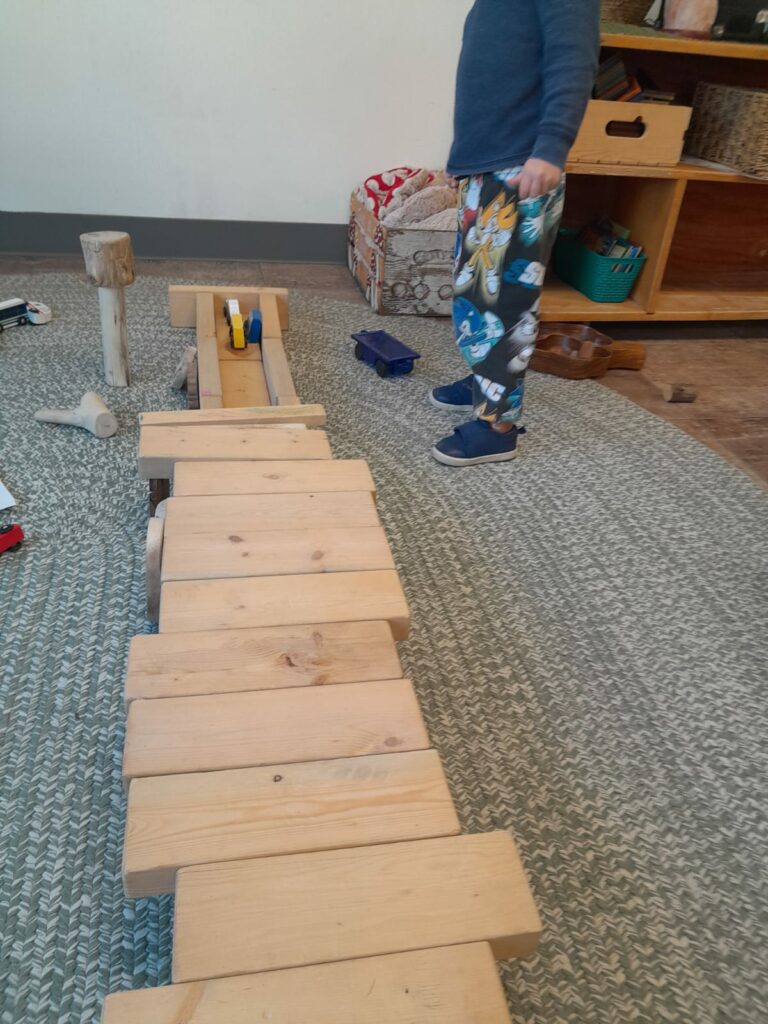
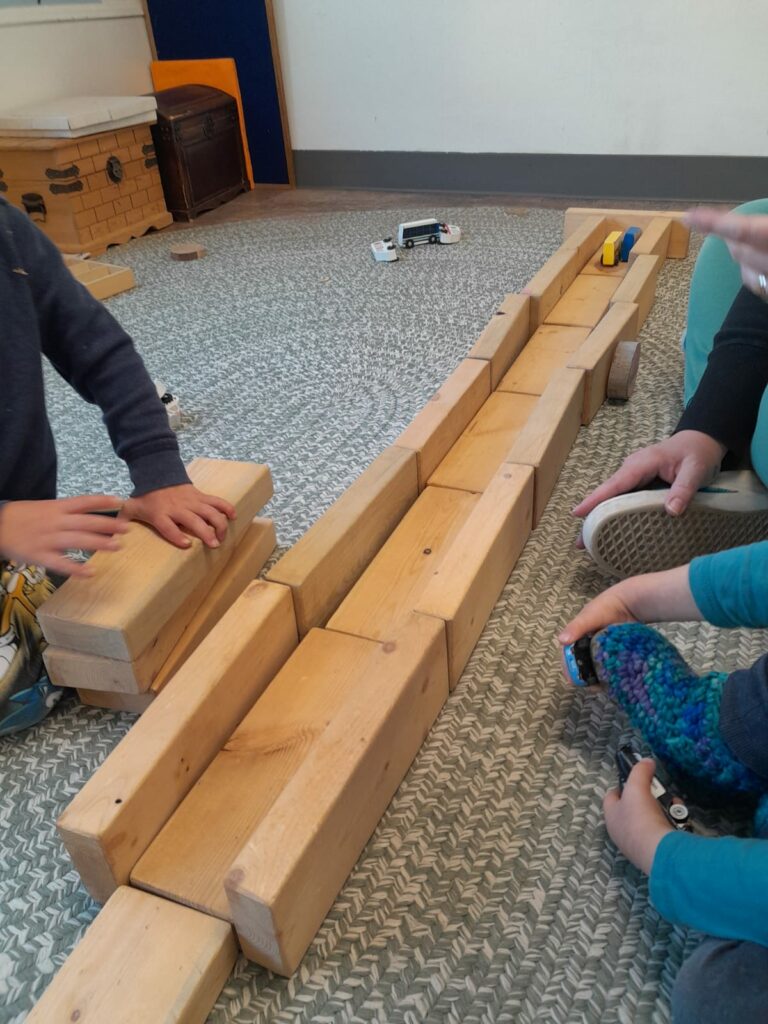
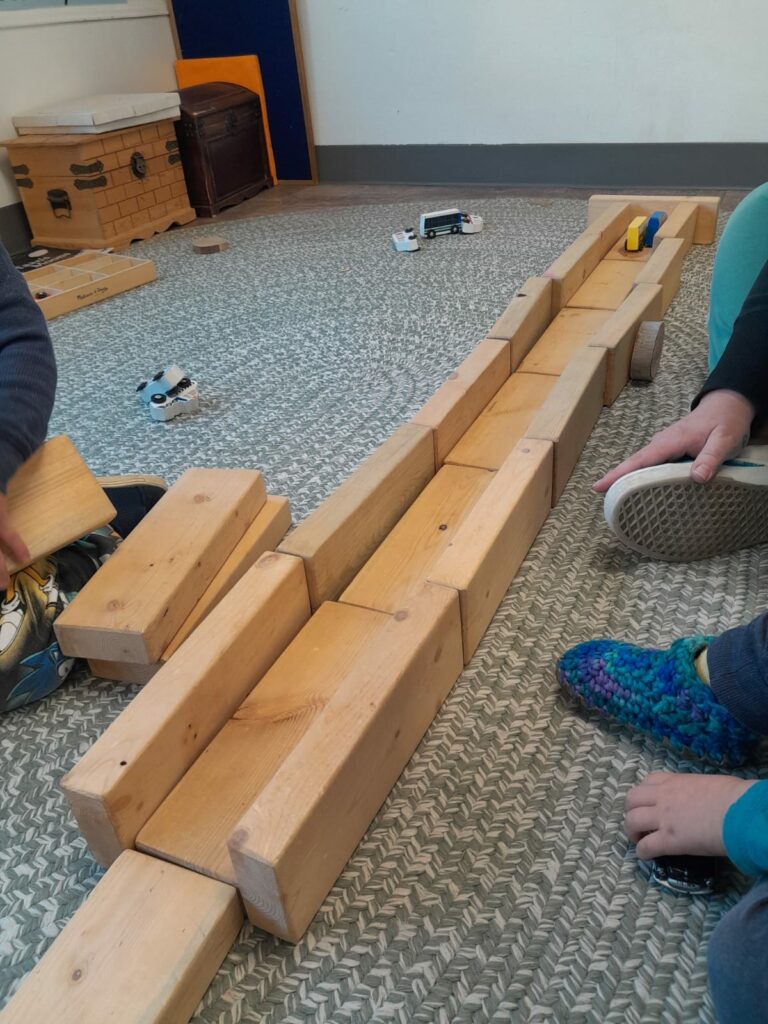
Drawing of Wood Blocks Provocations
I made a small provocation with the wood blocks on a table, and we decided to draw it on our paper.
Wren drew her house on the paper and she pointed to her rooms, and kitchen stairs on the paper.
Everly likes to draw castles as she is the princess of the castle
For Meavis: This is my House
: It is for Mom
Jack: I am drawing a Tower
Each child carefully draws by watching the provocation on the table. Some come up with the idea of parking cars in front of the house. When Everly draws the castle points on Everly’s drawing and says the castle is big and needs a King.
Torvi draws a picture of her house.
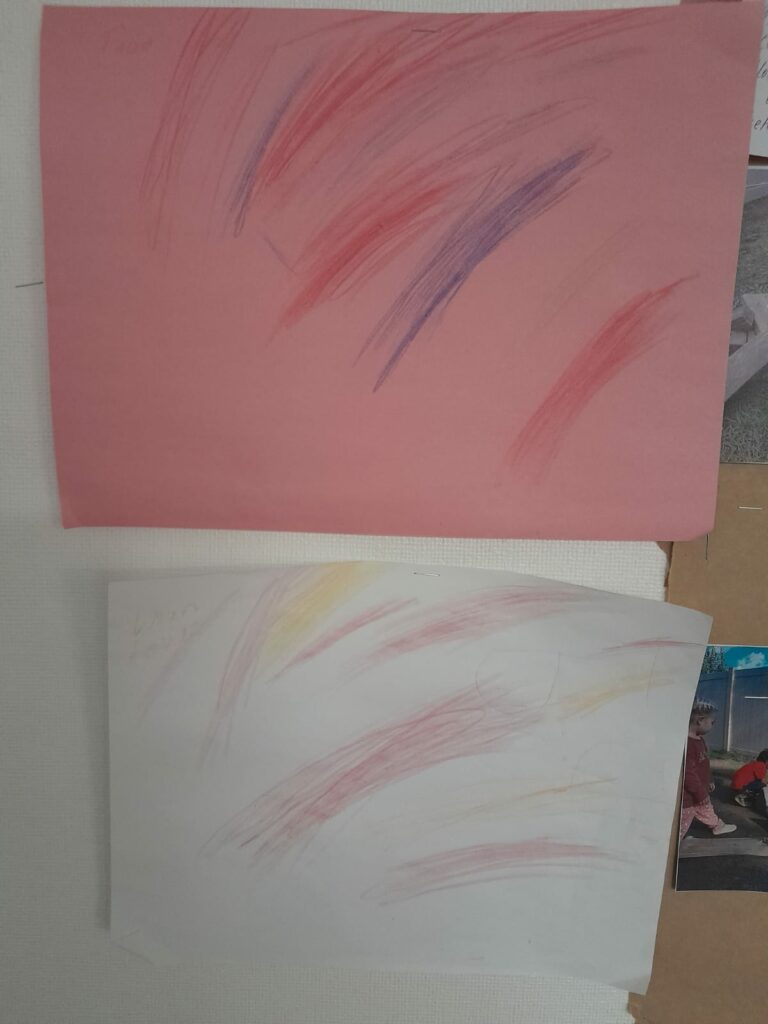
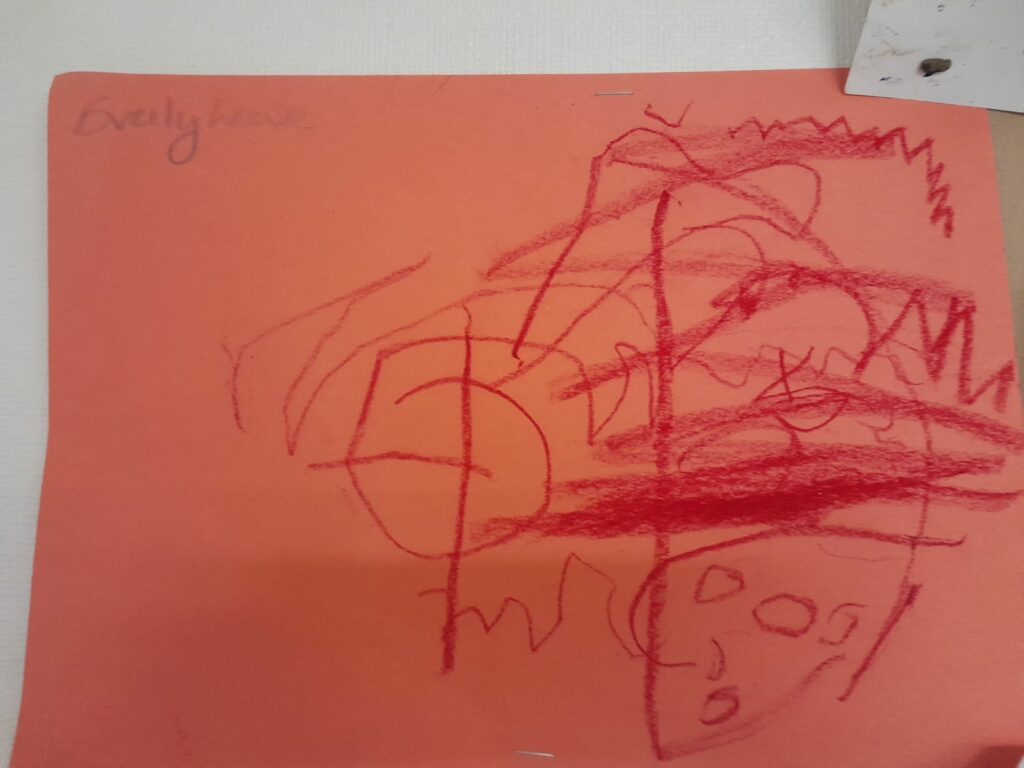
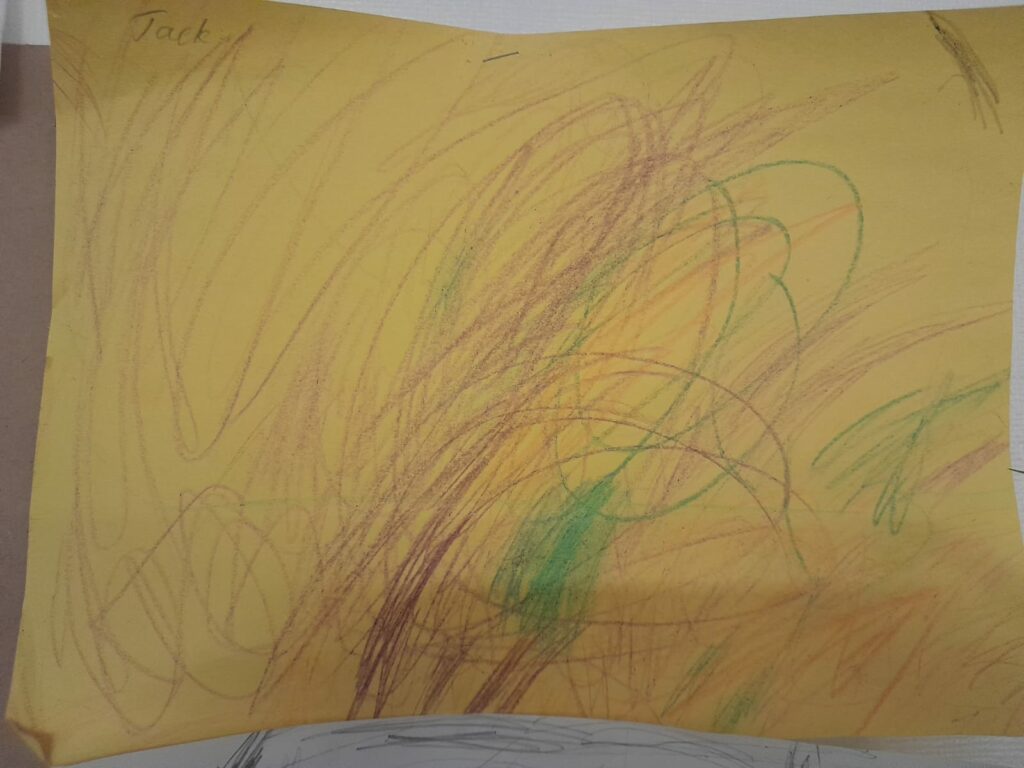
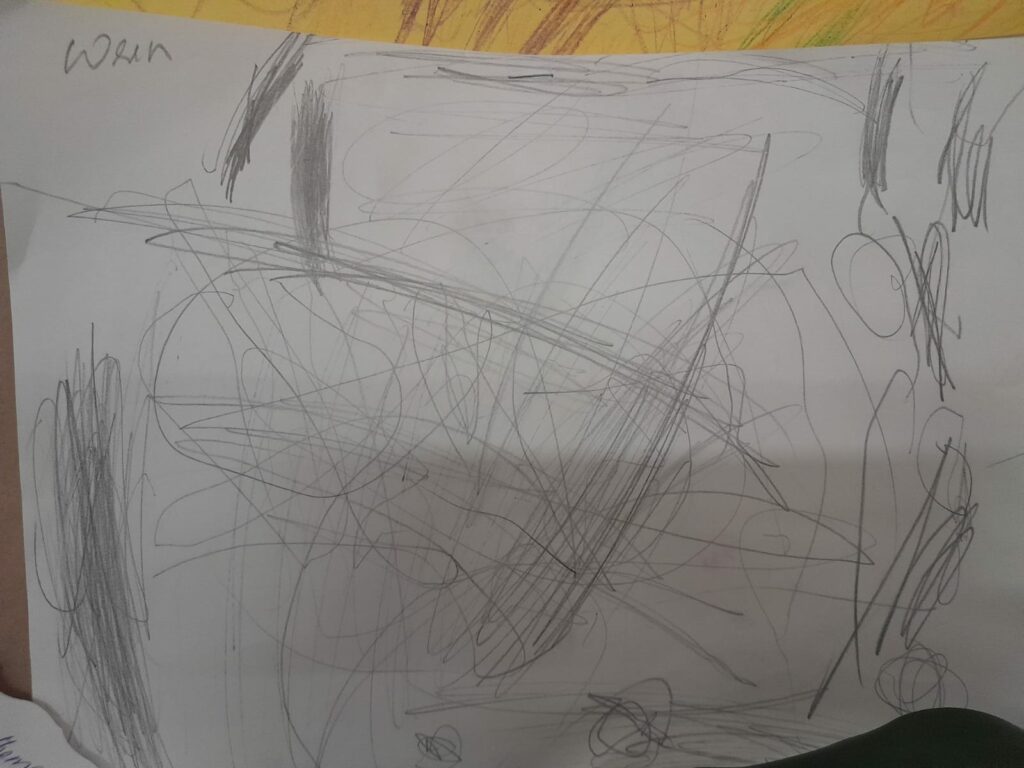
Extended the Woodblock activity by adding Loose parts
One day I decided to bring some loose parts materials to the center to extend the activity of the children with wood bocks. I create a provocation in the yard with cardboard boxes, wood blocks, fire trucks, gems, wheelbarrows, etc.
I wonder how the children are going to extend their construction using these loose parts.
Eric Started piling blocks in the cardboard box. He first took the big card box and arranged the blocks fit in the box. Then he collected a small box and gathered the blocks that fit in the box. He lines up the boxes and all through the outside session he has done the same. Dharan and Ternwell played with Fire Trucks on the wood blocks. Jasper played with cars assuming the blocks as a bridge. Some grab the gems from the provocation and some building upon the provocation assume a house.
As the BC ELF principle states Environments are integral to well-being and learning. The environment is referred to as a third teacher and helps shape the children’s experience. The children learn from their relationships with the people, materials, and spaces around them. As in the BCELF, “Different materials that children encounter invite different kinds of participation and engagement. Some materials are limited in how they can be used while others have possibilities for experimentation”. In the loose part activity, the children used materials in different ways, some found fun in the process of collecting and stocking in the box. Some played with tucks and cars, while others were in the construction process. All these activities create a holistic learning environment for the children.
